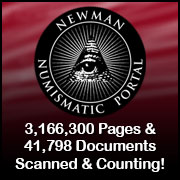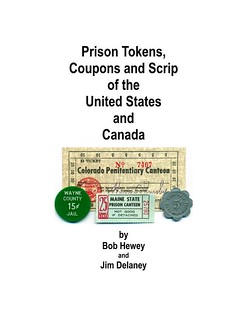
About UsThe Numismatic Bibliomania Society is a non-profit association devoted to the study and enjoyment of numismatic literature. For more information please see our web site at coinbooks.org SubscriptionsThose wishing to become new E-Sylum subscribers (or wishing to Unsubscribe) can go to the following web page link MembershipThere is a membership application available on the web site Membership Application To join, print the application and return it with your check to the address printed on the application. Print/Digital membership is $40 to addresses in the U.S., and $60 elsewhere. A digital-only membership is available for $25. For those without web access, write to: Charles Heck, Treasurer AsylumFor Asylum mailing address changes and other membership questions, contact Chuck at this email address: treasurer@coinbooks.org SubmissionsTo submit items for publication in The E-Sylum, write to the Editor at this address: whomren@gmail.com
BUY THE BOOK BEFORE THE COIN |
- WAYNE'S WORDS: THE E-SYLUM NOVEMBER 1, 2020
- KOLBE & FANNING AUCTION SALE 158 ANNOUNCED
- NEW BOOK: PRISON TOKENS OF THE U.S. AND CANADA
- NEW BOOK: BANKNOTES OF NEW ZEALAND TRADING BANKS
- VIDEO: AUBREY BEBEE INTERVIEWED
- VIDEO: THE ANS “GREATEST COINS” SERIES
- VIDEO CONFERENCE: GOBRECHT DOLLARS AT THE ANS
- SACAGAWEA MODEL RANDY'L TETON SPEAKS AT SCHOOL
- NOTES FROM E-SYLUM READERS: NOVEMBER 1, 2020
- NEW YORK'S NEW NUMISMATIC WALKING TOUR
- THE BRAILLE COINS OF ECUADOR
- VOCABULARY TERM: NICKEL-SILVER
- FRANCES MARIA KEELER MARSHALL (1810-1879)
- THE LEGENDARY COLLECTION OF WALDO NEWCOMER
- OLYMPIC CHAMPION SWIMMER DARA TORRES MEDAL
- CUSTOM AUGMENTED REALITY BANKNOTES OFFERED
- PAN FALL 2020 SHOW SUCCEEDS DESPITE PANDEMIC
- COLTRANE COLLECTION PART I U. S. CURRENCY PREVIEW
- DANIEL FRANK SEDWICK AUCTION 28 ANNOUNCED
- NUMISMATIC AUCTIONS LLC SALE 65 CATALOG READY
- NUMISMATIC NUGGETS: NOVEMBER 1, 2020
- GOLD IDES OF MARCH COIN REALISES $4M
- ELIZABETH I GOLD SOVEREIGN
- ENGLAND'S FIRST MILLED CROWN
- THE CROW, THE PITCHER, AND THE PEBBLE
- NOTGELD TALES
- FEDERAL PRISON BANK OF ALCATRAZ OVERSTAMP
- BILL FIVAZ'S WORLD'S WORST TYPE SET
- LOOSE CHANGE: NOVEMBER 1, 2020
- FEATURED WEB PAGE: BEARD TAX
Click here to access the complete archive
Click here to unsubscribe (scroll down)
To comment or submit articles, reply to whomren@gmail.com
Content presented in The E-Sylum is not necessarily researched or independently fact-checked, and views expressed do not necessarily represent those of the Numismatic Bibliomania Society.
WAYNE'S WORDS: THE E-SYLUM NOVEMBER 1, 2020
 New subscribers this week include:
Michael Louis John Winckless, courtesy Andrew Burnett, former Deputy Director-General of The British Museum;
and
Bruno Ovejero-Silva from Tucumán, Argentina, courtesy of Adrián Gonzalez-Salinas.
Welcome aboard! We now have 6,591 subscribers.
New subscribers this week include:
Michael Louis John Winckless, courtesy Andrew Burnett, former Deputy Director-General of The British Museum;
and
Bruno Ovejero-Silva from Tucumán, Argentina, courtesy of Adrián Gonzalez-Salinas.
Welcome aboard! We now have 6,591 subscribers.
Thank you for reading The E-Sylum. If you enjoy it, please send me the email addresses of friends you think may enjoy it as well and I'll send them a subscription. Contact me at whomren@gmail.com anytime regarding your subscription, or questions, comments or suggestions about our content.
This week we open with a new numismatic literature auction, two new books, updates from the Newman Numismatic Portal, and the American Numismatic Society.
Other topics this week include Randy'l Teton, New York coin dealers, the braille coins of Ecuador, collectors Mrs. Marshall and Waldo Newcomer, the PAN show, multiple auction previews, the gold EID MAR coin sale, notgeld, the Alcatraz overstamp, and the beard tax.
To learn more about an an original subscription set of Sylvester S. Crosby's Early Coins of America, prison tokens, New Zealand banknotes, dealer Aubrey Bebee, Gobrecht Dollars, masked numismatics, nickel-silver, Craig silver and the greatest collection never to appear at auction, read on. Have a great week, everyone!
Wayne Homren
Editor, The E-Sylum
KOLBE & FANNING AUCTION SALE 158 ANNOUNCED
Hot on the heels of their great P. Scott Rubin library sale, here's the announcement for another super Kolbe & Fanning sale later this month. Great material!! -Editor
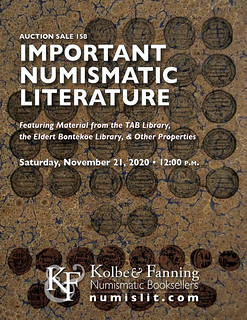 Kolbe & Fanning Numismatic Booksellers are announcing our Sale 158, which will be held on Saturday, November 21, 2020. The 467-lot sale features material from the TAB Library of works on ancient coins, the extensive working library of Eldert Bontekoe, and other properties. Most heavily focused on books and catalogues relating to ancient coins, the sale also features a substantial section on world coins and a smaller, but choice, selection of items of American interest.
Kolbe & Fanning Numismatic Booksellers are announcing our Sale 158, which will be held on Saturday, November 21, 2020. The 467-lot sale features material from the TAB Library of works on ancient coins, the extensive working library of Eldert Bontekoe, and other properties. Most heavily focused on books and catalogues relating to ancient coins, the sale also features a substantial section on world coins and a smaller, but choice, selection of items of American interest.
Some highlights of the sale include:
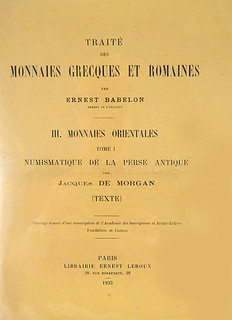
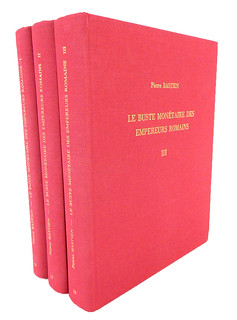
Lots 19 and 27
Lot 19: Joel Malter's well-preserved set of Jacques de Morgan's two-volume work on ancient Persian coins, the conclusion of the Traité des monnaies grecques et romaines
Lot 27: Pierre Bastien's extraordinary three-volume study of Roman numismatic portraiture, Le buste monétaire des empereurs romains
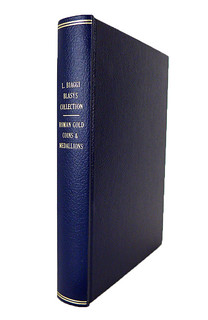
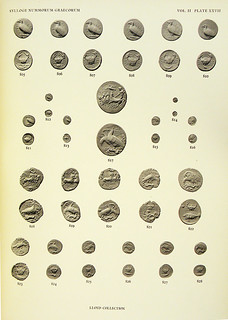
Lots 29 and 216
Lot 29: a bound provenance record of the magnificent L. Biaggi Blasys collection of Roman gold coins and medallions
Lot 216: Edward T. Newell's set of SNG Lloyd, complete in eight parts and bound in one volume
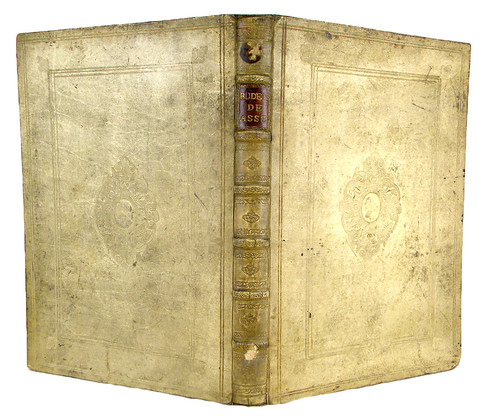
Lot 44
Lot 44: a 1542 folio edition of the first numismatic book, Guillaume Budé's De asse et partibus eius, elegantly printed in Paris by Michel de Vascosan
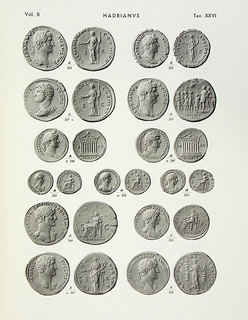
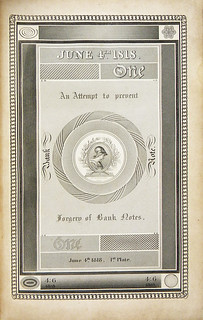
Lots 141 and 388
Lot 141: a fine set of Giuseppe Mazzini's Monete imperiali romane, illustrating over 8000 coins from one of the finest collections ever formed
Lot 388: the landmark 1819 work on preventing the forgery of bank notes, published by the Society of Arts and including a number of exceptional engravings
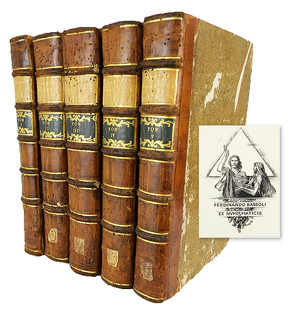
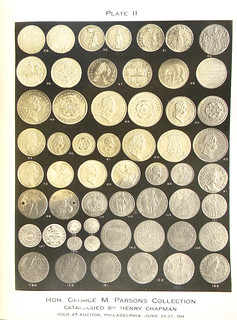
Lots 399 and 410
Lot 399: Dr. Bassoli's set of Zanetti's monumental study of Italian coinage, Nuova raccolta delle monete e zecce d'Italia (1775-1789)
Lot 410: a well-preserved copy of Henry Chapman's 1914 catalogue of the George Parsons collection of American and Canadian coins and medals, illustrated with 13 very fine photographic plates
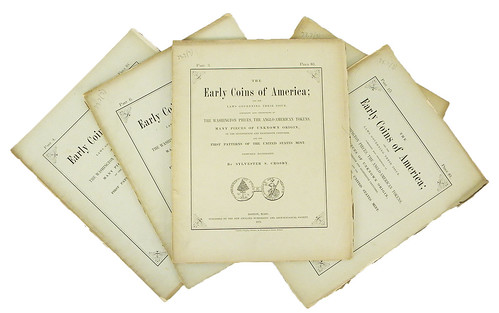
Lot 414
Lot 414: an original subscription set of Sylvester S. Crosby's Early Coins of America, the most important American numismatic book ever published, unbound and still in the original printed paper covers.
Register early to bid online
Bids may be placed via post, email, fax or phone, as well as online. Kolbe & Fanning is using Auction Mobility as our third-party online bidding platform. Auction Mobility is an app-based platform allowing users the ability to participate in the sale through phones, tablets and computers. To register for the sale, bidders must go to
bid.numislit.com
and sign up. Once you have set up an account, you may browse lots, place advance bids, or participate in the live sale online. Those wishing to participate on their devices can download the new Kolbe & Fanning app through the Apple or Google Play Store.
Bids placed via post, email, fax or phone must be received by Friday, Nov. 20, the day before the sale, in order for them to be processed. Advance absentee bids may also be placed at any time online at bid.numislit.com; live internet bidding will be available during the sale itself through the same platform.
Kolbe & Fanning Numismatic Booksellers LLC is a licensed and bonded auction firm in the State of Ohio. For more information, please see the Kolbe & Fanning website at bid.numislit.com or email David Fanning at df@numislit.com.
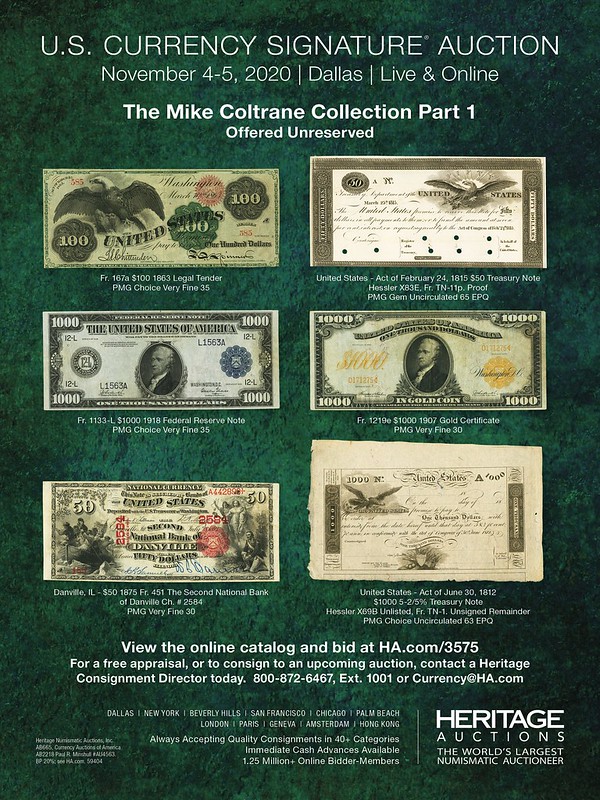
NEW BOOK: PRISON TOKENS OF THE U.S. AND CANADA
"After over two years of hard work Bob Hewey and Jim Delaney have finally completed Prison Tokens, Coupons and Scrip of the United States and Canada. 389 pages in full color and downloadable for free. The book is on the Newman Numismatic Portal published by the libraries of Washington University in St. Louis. To get your copy go to:
https://nnp.wustl.edu/library/book/589917"
Here's the text of the book's Foreword. -Editor
You may ask, “why were there special kinds of money used in prisons, jail and reformatories?” There are good reasons not to allow legal tender coins and bills in the hands of prisoners. The ready availability of such currency could encourage bribery, extortion, gambling and facilitate acquisition of contraband and escapes. Still, there needs to be some type of money so that inmates can purchase discretionary items, such as snacks, tobacco, toiletries and reading and writing supplies. This catalog will focus on the token coinage and scrip issued to address these problems in the United States and Canada.
According to our research, the first significant numismatic look at this subject is contained in an article published in 1960 by Jack F. Burns, Research Associate, Section of Coins and Medals, Carnegie Museum. More recently, Jerry Zara's Prison Tokens and Medals of the United States was published by Paul Cunningham in 1992. This 162-page hardcover book provided the most comprehensive look at the topic to date, and this new catalog makes occasional reference to Zara's work and cross-references our listings to his numbers where possible.
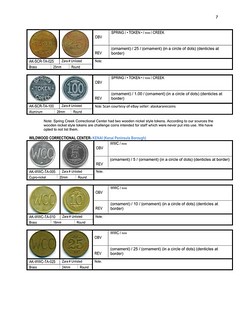
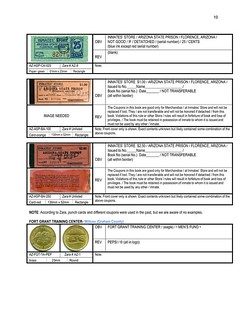
The first widely used alternative currency in prisons and jails were tokens. While these reduced the chance of bribery of correction officers and hindered escape, they did not eliminate their use for gambling, contraband and extortion. To counter this, institutions would put limits on the value of such tokens that the inmate could draw from an account or have in his or her possession. Other than tokens, coupons issued in booklets or attached as tear-offs to cards, punch cards and credit slips have been used in prisons to address the purchasing needs of the inmates. Now, as with the transportation industry, I'm sure that electronic cards have come into use, replacing other forms of scrip. But the scrip currency of our penal institutions makes an interesting and challenging field for collecting.
There were a number of at-risk youth and truant school institutions set up for delinquent or otherwise wayward boys and girls. Those that were part of the State or Provincial Board of Corrections are included in the general listing. However, there were private, non-official institutions, and we have listed these in a separate section. One of the best known of these institutions is Boys Town founded in 1917 in Nebraska. It issued tokens for its Student Bank in denominations from 5 (cents) to 5.00 (dollars). Another institution was the George Junior Republic, first established in 1895 in Freeville, NY. Other similar “Junior Republic” institutions followed, many issuing tokens and/or paper scrip. Many of the tokens issued by the George Junior Republics had dates of issue, ranging from 1896 to 1946.
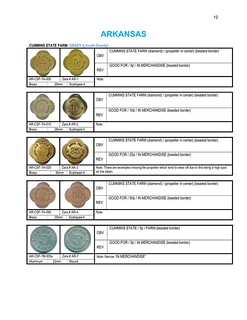
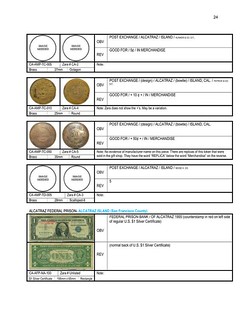
Newman Numismatic Portal Project Coordinator Len Augsburger adds:
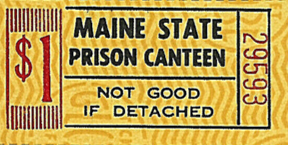 "The main body of the book consists of a state by state (and province) listing of known issues, and a quick check of eBay reveals an active collector market for these money substitutes.
"The main body of the book consists of a state by state (and province) listing of known issues, and a quick check of eBay reveals an active collector market for these money substitutes.
"Tokens appear to be the most common form of prison money, struck in base metals at minimal cost. Various shapes are encountered, perhaps to discourage counterfeiting, including quatrefoils and octagons. Plastic and wooden pieces also appear in the series.
"One finds also scrip and coupon books, the latter used to suppress trading between prisoners, who must present the book along with the coupon. This is a scheme shared by universities, when distributing student tickets for athletic events."
As with all nonrestricted Newman Numismatic Portal or Internet Archive content, users can download copies in a variety of formats for their own personal reading and research use. -Editor
Bob adds:
"To open the free download scroll down to the title page on a black background. In the lower left you will see the title (in white lettering). Click that to open the download page. Scroll down and select the type of format you wish and enjoy."
To read or download the book on NNP:
Prison Tokens, Coupons and Scrip of the United States and Canada
(https://nnp.wustl.edu/library/book/589917)
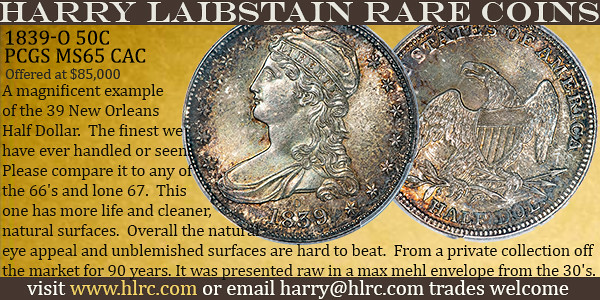
NEW BOOK: BANKNOTES OF NEW ZEALAND TRADING BANKS
Author Robert Pepping submitted this overview of his new book on the banknotes of New Zealand Trading Banks. Congratulations! -Editor
Bank of New Zealand
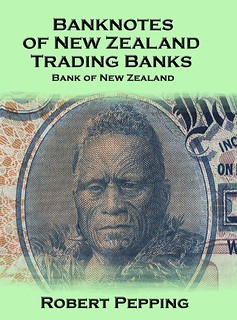 In this 278 page book, I have attempted to provide facts, stories and information on each issued Bank of New Zealand note in New Zealand. These notes were issued from 1861 to 1934. I have not attempted to write an account of the Bank of New Zealand notes issued in Australia, but I have included information on the notes that were originally printed for issue in New Zealand but later modified for use in either Fiji or Samoa.
In this 278 page book, I have attempted to provide facts, stories and information on each issued Bank of New Zealand note in New Zealand. These notes were issued from 1861 to 1934. I have not attempted to write an account of the Bank of New Zealand notes issued in Australia, but I have included information on the notes that were originally printed for issue in New Zealand but later modified for use in either Fiji or Samoa.
The chapters in the book have not been ordered chronologically but by note denomination, from Ten Shillings to One Hundred Pounds. Some information has been repeated in later chapters to provide the best possible record of that note issue. For each chapter, information on each known issued, specimen or trial note has been recorded. This part of each chapter is not definitive as unknown notes will undoubtedly be revealed in the future. However, it provides a very exhaustive starting point for a collector of these notes and any further editions of the book will include updated information. During the period when Bank of New Zealand notes were issued, a number of counterfeit notes of various denominations and issues were produced. Their stories along with information on these forgeries have also been included in the relevant chapters.

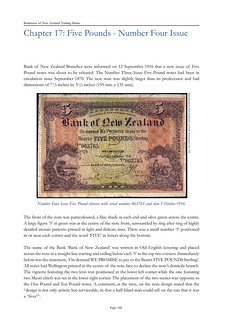
The section in each chapter on specimen notes will hopefully give the reader more information on a particular note issue as many of the specimen notes carried annotated dates to provide a particular timeframe when the notes were printed or issued. Along with watermarks in the note paper, the method by which the printer marked a note as a specimen provides further information about a specimen note's date of origin. As the majority of the BNZ notes were printed by Bradbury Wilkinson, information in this section will appeal to anyone who has an interest in notes produced by this printer.
The intention of the book is not to create or endorse a cataloguing system but to provide a coherent overview of information on the Bank of New Zealand notes.
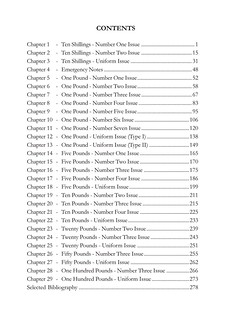

The book (ISBN 978-0-473-53551-3) has a soft cover and has been commercially printed in color. Copies are US$55.00 plus P&H and can be obtained from emailing Robert on nzhnoted@gmail.com

VIDEO: AUBREY BEBEE INTERVIEWED
These are selections from the David Lisot Video Library that feature news and personalities from the world of coin collecting. David has been attending coin conventions since 1972 and began videotaping in 1985. The Newman Numismatic Portal now lists all David's videos on their website at:
https://nnp.wustl.edu/library/multimediadetail/522852
Here's one on dealer Aubrey Bebee. -Editor
ANA Numismatic Personality: Aubrey Bebee, August 9, 1986.
VIDEO: 21:20.
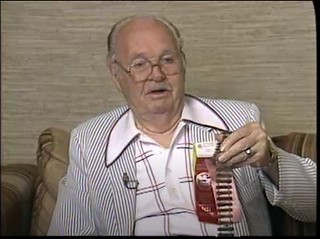 Perhaps no person is important to hobby of numismatics and the American Numismatic Association than coin dealer Aubrey Bebee. Always a staunch support of the organization he donated the famous 1913 LIBERTY NICKEL to the ANA Money Museum. Hear stories of Bebee and his numismatic journey interviewed by numismatist and journalist David Lisot.
Perhaps no person is important to hobby of numismatics and the American Numismatic Association than coin dealer Aubrey Bebee. Always a staunch support of the organization he donated the famous 1913 LIBERTY NICKEL to the ANA Money Museum. Hear stories of Bebee and his numismatic journey interviewed by numismatist and journalist David Lisot.
An excerpt of the video is available for viewing at:
https://nnp.wustl.edu/library/book/557343

VIDEO: THE ANS “GREATEST COINS” SERIES
American Numismatic Society has announced a new video series. -Editor
The American Numismatic Society is pleased to announce the Greatest Coins video series.
In this series, short videos realized by our curatorial team will examine coins in the American Numismatic Society's collection, carefully selected for their historical fame and significance. Intended for a wide audience of experts and non-experts alike, these videos will feature multimedia materials that contribute not only to the understanding of the historical and cultural context in which the selected coins were produced, but also to their reception history. The videos will be released on a monthly basis.
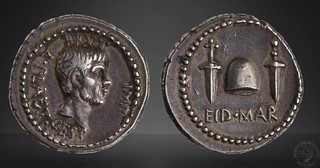 In the first episode of the series (already available online), Assistant Curator of Roman Coins, Dr. Lucia Carbone, looks at what is probably the most celebrated Roman coin, the EID MAR (Ides of March) denarius. This coin was struck under the authority of Julius Caesar's main assassin, Marcus Junius Brutus, in 43-42 BCE, to commemorate Caesar's assassination on the Ides of March 44 BCE. Shortly after, Brutus died on the battlefield, sealing the end of the Republic.
In the first episode of the series (already available online), Assistant Curator of Roman Coins, Dr. Lucia Carbone, looks at what is probably the most celebrated Roman coin, the EID MAR (Ides of March) denarius. This coin was struck under the authority of Julius Caesar's main assassin, Marcus Junius Brutus, in 43-42 BCE, to commemorate Caesar's assassination on the Ides of March 44 BCE. Shortly after, Brutus died on the battlefield, sealing the end of the Republic.
In the second episode (available in November), Assistant Curator of the Americas, Dr. Jesse Kraft, discusses the Brasher Doubloon. The coin was struck by New York goldsmith, Ephraim Brasher in 1787, possibly as a trial piece to present to the New York State legislature in his attempt to receive a contract to produce coins on a large scale. Though he never received a contract, the Brasher Doubloon is considered the first gold coin struck in the United States.
To watch the first episode (or any of the ANS videos), see:
The ANS's Greatest Coins: the EID MAR denarius. A valuable coin celebrating Caesar's assassination.
(https://www.youtube.com/c/NumismaticsOrg/videos)
To read the complete article, see:
Press Release: Announcing the “Greatest Coins” video series.
(http://numismatics.org/press-release-the-american-numismatic-society-is-please-to-announce-the-greatest-coins-video-series/)

VIDEO CONFERENCE: GOBRECHT DOLLARS AT THE ANS
The American Numismatic Society Money Talks lectures are being held online. Although open to members only, these conferences are a great reason to join ANS. If interacting live isn't an option for you, the talk will be available as a video afterwards. -Editor
This Money Talks will be held live on zoom.
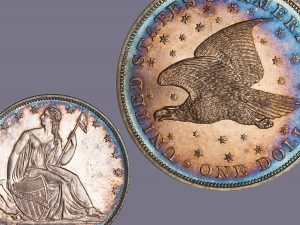 The ANS holds the world's largest collection of Flying Eagle or Gobrecht Dollars in the world, with an example of every variety save one, as well as a group of extremely rare trial strikes and related patterns. The majority of the collection was donated by Dr. Julius Korein in 2008. The Flying Eagle Dollar remains an actively researched and highly controversial area of United States numismatics, and the ANS collection constitutes a unique and invaluable resource in their study. This presentation will explore the origins of the coin and the misadventures attending its design, leading to the final abandonment of the iconic flying eagle motif. Using never-before seen high-resolution images of coins from the collection, competing theories will be explored and discussed in an effort to better understand how and when the coins were produced and for what purpose.
The ANS holds the world's largest collection of Flying Eagle or Gobrecht Dollars in the world, with an example of every variety save one, as well as a group of extremely rare trial strikes and related patterns. The majority of the collection was donated by Dr. Julius Korein in 2008. The Flying Eagle Dollar remains an actively researched and highly controversial area of United States numismatics, and the ANS collection constitutes a unique and invaluable resource in their study. This presentation will explore the origins of the coin and the misadventures attending its design, leading to the final abandonment of the iconic flying eagle motif. Using never-before seen high-resolution images of coins from the collection, competing theories will be explored and discussed in an effort to better understand how and when the coins were produced and for what purpose.
ANS Members only. RSVP to membership@numismatics.org. This lecture will be recorded and uploaded to YouTube for later viewing.
Money Talks: Numismatic Conversations is supported by an ANS endowment fund generously given in honor of Mr. Vladimir Clain-Stefanelli and Mrs. Elvira Clain-Stefanelli.
To read the complete article, see:
Money Talks | The Ephemeral Flying Eagle: Gobrecht Dollars in the ANS Collection
(http://numismatics.org/money-talks-the-ephemeral-flying-eagle-gobrecht-dollars-in-the-ans-collection/)

SACAGAWEA MODEL RANDY'L TETON SPEAKS AT SCHOOL
Local newspapers are great places to find interviews with numismatic personalities such as this one with Sacagawea coin model Randy'L Teton. -Editor
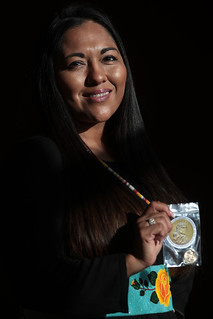 When most people envision Sacagawea, they think of her portrait on the golden dollar coin. They're thinking of a Fort Hall resident.
When most people envision Sacagawea, they think of her portrait on the golden dollar coin. They're thinking of a Fort Hall resident.
Randy'L Teton, the spokeswoman for the Shoshone-Bannock Tribes, modeled for the coin in 1998 and is the only living person who appears on U.S. currency. She spoke to students at Holy Rosary Catholic School on Friday morning about her experience and her Shoshone-Bannock heritage for the 20th anniversary of the coin's official debut by the United States Mint.
Teton was a college student studying at the Institute of American Indian Arts in Santa Fe when she was approached about appearing on the coin. Her mother was the tribal director and connected her with Glenna Goodacre, a New Mexican artist who was submitting designs for the coin. Sacagawea has no living relatives but was a member of the Shoshone tribe and grew up near Salmon before she guided Lewis and Clark's expedition through the final stage of their western expedition.
Teton remembered Goodacre saying that she "looked Shoshone" when they first met. They borrowed a decades-old deerskin dress from a museum collection for her to wear during the session. When the Treasury announced the 10 finalist designs for the Sacagawea coin and posted the images online, eight of them were Teton.
"I had to go to the computer pod on my campus at four in the morning because it was going to be posted on the internet at 6 eastern. I went on the Treasury website and boom, there was my face," Teton said.
Teton brought a collection of traditional Shoshone clothes to show the students: shell earrings she wore while modeling for the coin, otter pelts that would be woven into her hair during ceremonial events and the top of another deerskin dress.
That dress was made for Teton by her grandmother using eight deer skins, featuring elaborate beadwork showing roses and a meadowlark representing her Shoshone name "Hedow."
"This is something we have to cherish today because not a lot people still do this kind of work," Teton said.
At the end of the presentation, Teton took questions from the Holy Rosary students and passed out new versions of the Sacagawea coin for them to take home.
To read the complete article, see:
Sacagawea coin model speaks to Holy Rosary class
(https://www.postregister.com/news/local/sacagawea-coin-model-speaks-to-holy-rosary-class/article_49b3f55e-a0de-5967-b56a-c137baabff62.html)

NOTES FROM E-SYLUM READERS: NOVEMBER 1, 2020
Bernard Olij's Bookplate
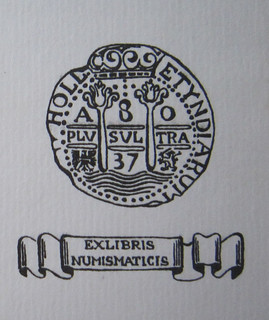 Bernard Olij of
Malang, Indonesia writes:
Bernard Olij of
Malang, Indonesia writes:
"I'd like to share a bookplate (exlibris) I designed for myself. The design is based on a Spanish 8 Reales, with details changed (a.b.olij, born 1937, lived in the East and West Indies, etc.)"
Very nice! Great idea. I like it. Thanks. -Editor
To read the earlier E-Sylum article, see:
ALAIN POINSIGNON NUMISMATIC LIBRARY BOOKPLATES
(https://www.coinbooks.org/v23/esylum_v23n43a02.html)
Schools at War Jeep Treasury Certificate
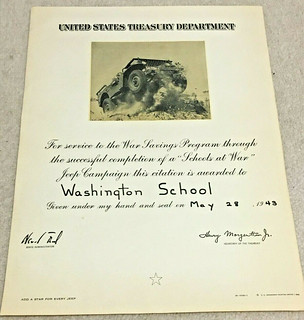 Justin J. Perrault writes:
Justin J. Perrault writes:
"In response to George Cuhaj's Treasury Certificate for the 1970s CENT ("penny") shortage, I came across on eBay another interesting bit of numismatic ephemera issued by the Treasury Dept. during WWII as part of a War Jeep Campaign amongst the schools."
Interesting WWII ephemera. I wasn't familiar with this program. I'm old, but not THAT old. -Editor
To read the complete lot description, see:
1943 WWII Patriotic Certificate Schools at War Jeep Campaign, US Treasury Dept
(https://www.ebay.com/itm/1943-WWII-Patriotic-Certificate-Schools-at-War-Jeep-Campaign-US-Treasury-Dept/264908251839)
To read the earlier E-Sylum article, see:
NOTES FROM E-SYLUM READERS: OCTOBER 25, 2020 : 1970s Penny Shortage Treasury Special Citation Certificate
(https://www.coinbooks.org/v23/esylum_v23n43a12.html)
Colonial Coin Collectors 2020 Virtual Convention

As noted earlier, the Colonial Coin Collectors Club (C4) will be holding their 2020 convention online, and everyone is welcome to attend. Jim Glickman reminded me to remind all of you, so here goes. For more information, see the earlier article or the C4 website, both linked below. -Editor
The Colonial Coin Collecting Club (C4) has released the schedule of online education programs as part of its virtual 2020 Convention, to take place November 12 – 14, 2020. These programs will be fully accessible on Zoom. The programs will appeal to collectors of every level of experience with colonial coins and currency, from the curious beginner to those with colonial expertise. You do not need to be a member of C4 to participate. A lineup of luminaries in the hobby has been assembled to deliver a varied and fascinating educational experience.
All programs will be available on Zoom, and will be one hour in length. A tutorial on how to use Zoom and more detailed information on how to join lectures will be posted on the C4 website in the “Convention” section: https://colonialcoins.org/conventions/
To read the earlier E-Sylum article, see:
COLONIAL COIN COLLECTORS 2020 VIRTUAL CONVENTION
(https://www.coinbooks.org/v23/esylum_v23n42a13.html)
Masked Numismatics
Regarding a non-numismatic article he'd recently seen,
Nick Graver writes:
"The illustration of Ben with a mask is rather clever."
I was unable to locate the particular article online, but the image it used is a stock photo similar to the one shown below. I also encountered a related one of a masked Queen Victoria in the Autumn 2020 Money & Medals newsletter. Signs of the times. -Editor
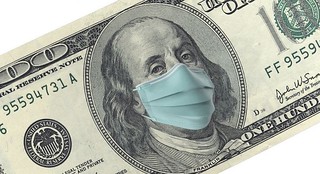
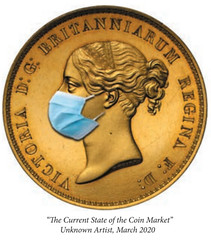
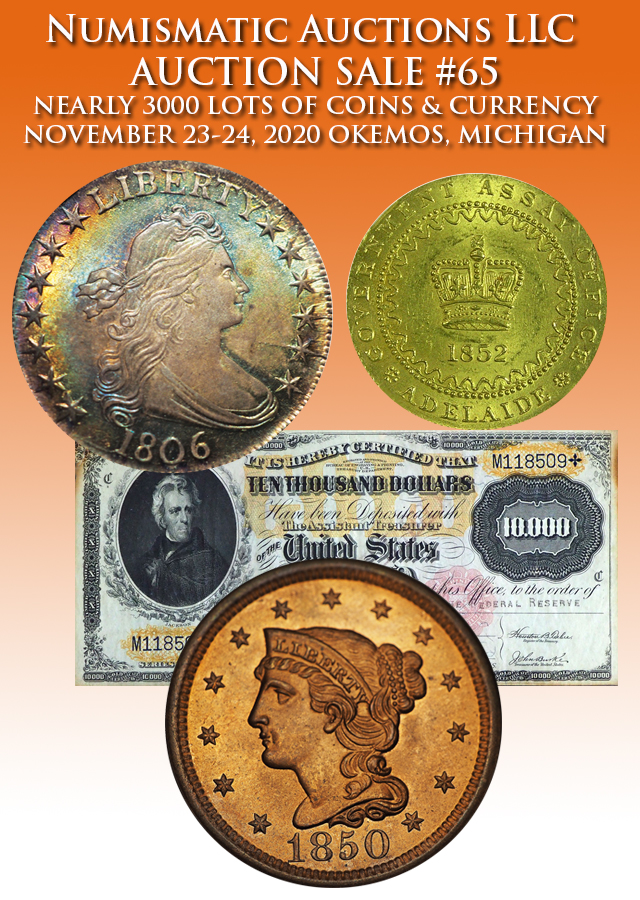
NEW YORK'S NEW NUMISMATIC WALKING TOUR
Paul Bosco submitted these notes on the new landscape of New York's rare coin district. Thanks! -Editor
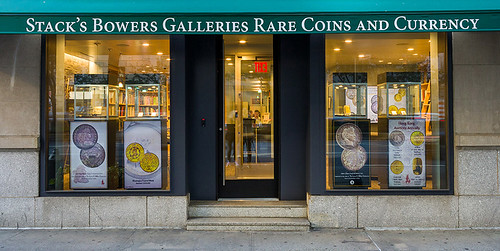
Stack's-Bowers has just opened its new store at 470 Park Ave, between 57th & 58th Streets. For more than half a century, they were located in the Salisbury Hotel on 57th Street, between 6th & 7th Aves, 3 1/2 blocks away. I think they were gently pushed out by the landlord/hotel. With their move, New York has a true rare coin district –for the THIRD time.
In the mid-1970s, “stagflation” not withstanding, Stack's had company, if not real competition, on 57th Street. I worked at Schulman Coin & Mint, 40 W57th. They operated from 1975-76, and then were closed by bankruptcy in January 1977.
Ben Stack, ever amiable, used to drop in at Schulman to chat with Gerry Bauman and buck up his spirits; Hans Schulman had departed for Europe and the company was in Chapter 11 bankruptcy. There were other well-wishers. I remember when “Dean of American Numismatics” Abe Kosoff stopped by with encouragement; Bauman quipped that Abe, standing over the junk box, may have pocketed a few coins. Mrs. Norweb came in and bought a copy of Friedberg (world gold coins).
Stack opined that Metropolitan Rare Coin Company, prestigiously located on a corner at 57th & 6th Ave, couldn't possibly make it, due to the rent: $6000/month. I think Schulman was paying more like $1500. Indeed, Metropolitan lasted only briefly (1974-75?). Steve Deeds, super-trader Robert L. Hughes, Neil S. Berman and other less-colorful but still well-known dealers worked there, but it is little remembered.
Per Berman, in a Numismatist article, the company never recovered from an armored-car robbery of 90% silver, but the rent couldn't've helped.
Harmer Rooke was located at 3 East 57th , across the street from Tiffany's. Their team included Joe Rose, Harvey Hoffer, Leo Dardarian, the mysterious David McClymont and others –quite a bit of numismatic talent. I believe they made a killing when they were bought out of their ground-floor lease by frock-flogger Ann Taylor.
Coen-Messer were also nearby, on 55th Street near 5th Ave. Stack's would send people with coins to C-M if they didn't want them. After Dan Messer died, Joel D. Coen made a fortune on bullion. Tommy Tesoriero worked there till Joel died— no one knows where Joel's millions disappeared, except maybe the girlfriend. Tommy ran Thomas and Company, an Arnie Saslow venture within Harmer Rooke's Gallery, before working at Stack's and Spink.
That made five stores within a quarter-mile stretch. There were four or five serious ancient coin specialists among them. Compare that to today, when words like Denarii and Aurei are more commonly used in Scrabble clubs than coin stores.
Mind you, there were other coin stores in midtown Manhattan, and a second “coin district” on and near Ann Street, in the financial district. Other serious players, like Lester Merkin (56th & 6th ) and New Netherlands (Charles Wormser & John Ford) had upper-floor offices.
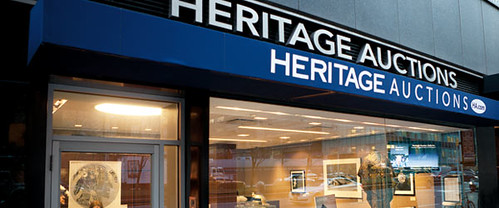
Now, with the relocation of Stack's-Bowers, there are three major coin stores within 250 feet. Heritage New York, which includes a coin department capably helmed by a rather young Sarah Miller, is also on Park Ave, just below 57th Street. Brigandi, for 50+ years located across the street from the famed Algonquin Hotel (44th Street), solved their greedy landlord problem by finding a decent lease on 57th , about 100 feet east of Park. Their store, with displays of US Paper Money, sports/entertainment memorabilia and autographs, is the most spacious NYC coin shop, and gorgeous.
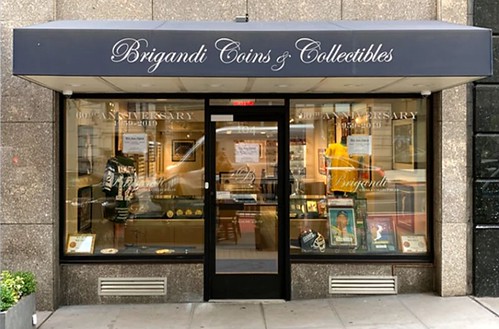
As Heritage was there first, perhaps they were the magnet that attracted the other two.
No other American city can boast of such a concentration of numismatic commerce, with the nation's two largest companies, and the formidable Brigandi, practically rubbing elbows. If that's not enough, walk another 5 minutes and there is also Royal Athena (57th between 3rd & Lexington), the antiquities behemoth, which handles ancients. Another 5-minute walk and you get to Manhattan Art & Antiques Center (2nd Ave between 55/56 th Sts), home to Morris Khouli (with antiquities and ancients), and of course my ramshackle gallery, certifiably an insanity but arguably the most diversified store in the world.
If not afraid of elevators, Spink New York has an office, 18 floors above W57th Street.
I began by saying “for the THIRD time”.
After WW2, New York City was home to 5% of the US population, and perhaps a bigger share of the coin trade. The epicenter was the West 40s, 44th Street up to the 47th Street Diamond District, and it was still thriving in 1964, when my father took me to the City, worlds away from the pleasant monotone of suburban Long Island. Shop after shop of coins, selling Coin World, selling 1964 Kennedy Half rolls for $10.50 (and openly laughing about it), buying Silver Certificates…. Walls and showcases teeming with coins I only knew from books and ads. My father bought an Unc Morgan, 1898-O or 1899-O, in a keychain bezel, for $2; the coin was worth face, just a prop to sell the high-margin keychain. I wanted a 1909-S Indian Head Cent in Fine, then a $125-35 coin (today $425), but I had capital of about $10. One shop had a golden-toned Uncirculated 1878-CC Trade Dollar, marked $350 (Today $15,000+).
Just like I can't remember if that Morgan was 1898 or 1899, I am not positive that I was in Morris Geiger's shop on 47th. One of the dealers called me “kid”. Morris called everyone “kid”. He is the only dealer who ever quoted Shakespeare to me, trying to get me down a little on a price.
Years later (1999) I was at Morris's booth in a Miami Beach exchange, stumbling into the place while seeking a Cuban sandwich. I was there at Federal government expense, a witness in the theft of a Large Cent dealer's inventory by some Russian-American punks. I dropped a few thousands, but was still “kid”.
And the 1878-CC? In 1997, in my Hal Walls auction, I sold a lustrous Unc, ex-John Willem, the finest chopmarked example, for $2600. Probably the closest I'll ever get to the coin I marveled at, when I was 14.
In a Harvey Stack reminiscence in The E-Sylum, he discusses the decision by Stack's to move from the West 40s to 57th Street, which was much more of a “carriage trade” destination. Probably, Stack's was foresighted. The ethos of the 1960s New York coin trade, a reflection of the Kennedy-Johnson economic prosperity, probably fueled by still-low rents, faded slowly but surely. For some time, the prospect of easy riches supported the market. There was free money in silver certificates and war nickels, and coins could still be plucked from circulation. Coin World's circulation has never been as high as in the mid-'60s. A hobby dominated by date-&-mint collecting, 1878 to date, had considerable accessibility. But in time, the lure of proof sets and 1950-D nickels came up short, and the surviving shops were fewer and fewer.
The '70s saw coin stores getting by on 90% silver and legalized gold, culminating in the 1979-80 bullion explosion – soon followed by collapsing prices of metals, diamonds and coins.
Today, the market is characterized by far greater sophistication and specialization, with auctions dominating total sales total. It's not all that surprising that the New York coin trade has centered itself on 57th Street, one of the world's most elite shopping districts.
If only it were possible to visit the city!
To read earlier E-Sylum articles, see:
ALAN V. WEINBERG ON THE HOBBY IN THE 1960S
(https://www.coinbooks.org/esylum_v13n16a22.html)
STACK'S BOWERS ON THE MOVE IN NEW YORK
(https://www.coinbooks.org/v23/esylum_v23n08a19.html)
STACK'S BOWERS GALLERIES OPENS NEW YORK LOCATION
(https://www.coinbooks.org/v23/esylum_v23n43a18.html)

THE BRAILLE COINS OF ECUADOR
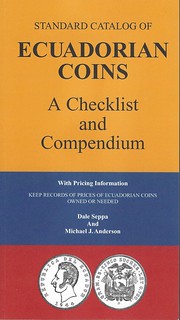 Tom Babinszki writes The Blind Coin Collector blog, and he asked me to look up a couple braille coins in Dale Seppa's new Standard Catalog of Ecuadorian Coins: the 1988-1991 10 Sucres (KM#92.2) and the 1991 50 Sucres (KM#93).
Tom Babinszki writes The Blind Coin Collector blog, and he asked me to look up a couple braille coins in Dale Seppa's new Standard Catalog of Ecuadorian Coins: the 1988-1991 10 Sucres (KM#92.2) and the 1991 50 Sucres (KM#93).
The catalog has little text in the modern section, and does not mention the braille dots. The coins are all pictured, and I see the dots on all 1988 denominations - 5, 10, 20, and 50 sucres. The 1991 coins aren't pictured, but I assume they have the same design. That makes eight different braille Ecuadorian coins. I reached out to Dale Seppa to confirm. -Editor
Dale writes:
"I have to admit that I was completely oblivious to the braille dots although I vaguely remember seeing an article about them at some point in the past.
"However, I did a quick search and I can confirm that both the W I D E date and narrow date 50 sucres dated 1991 do have the 5 dots at the base of the coin below the denomination and I enclose a couple of pictures. I had to double check as I was not sure if both wide and narrow dates had the dots."
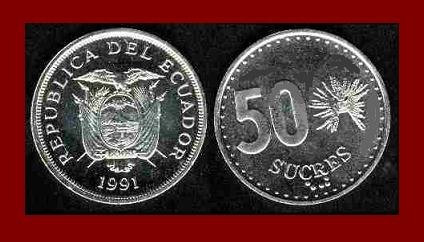
Ecuador 50 sucres 1991 with 5 Braille Dots Narrow Date
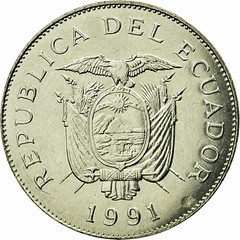
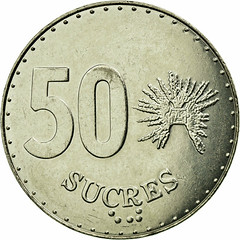
Ecuador 50 sucres 1991 with 5 Braille Dots Wide Date
Thanks, everyone. A great topic, but infrequently encountered in numismatics, unfortunately. -Editor
For more information, see:
ECUADOR 1991 50 SUCRES COIN KM#93
(https://world-coins-dealer.ecrater.com/p/1541327/ecuador-1991-50-sucres-coin-km93)
[#588164] Coin, Ecuador, 50 Sucres, 1991, EF(40-45), Nickel Clad Steel, KM:93
(https://www.ebay.com/itm/588164-Coin-Ecuador-50-Sucres-1991-EF-40-45-Nickel-Clad-Steel-KM-93-/193038018431)
To read the earlier E-Sylum article, see:
NEW BOOK: STANDARD CATALOG OF ECUADORIAN COINS
(https://www.coinbooks.org/v23/esylum_v23n43a05.html)
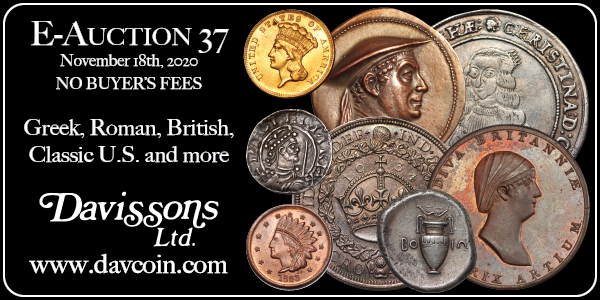
VOCABULARY TERM: NICKEL-SILVER
Dick Johnson submitted this entry from his Encyclopedia of Coin and Medal Terminology. Thanks. -Editor
Nickel-silver. An alloy of nickel, copper and zinc. Its gray-white color is in imitation of silver; but there is no silver in nickel-silver. Formerly this alloy was widely known as german-silver, but this term fell into disuse in World War I due to anti-German sentiment in England and America. While German-silver was known as early as the 1830s (from natural alloys found in Germany) it was not until the 1840s when experiments in England were conducted with brass. Nickel was added to brass until the gold-colored alloy turned silver-gray. By 1848 a successful nickel-brass alloy was in use, it was called albata.
There are many nickel-silver formulas: 55-65 copper, 5-25 nickel, 10-30 zinc.
Here are two common types:
65 CU 18 NI 17 ZN 8.75 sp gr 1110° melting point
55 CU 18 NI 27 ZN 8.69 sp gr 1055° melting point
Nickel-silver has a moderate use in the medallic field, mostly for badges, key tag medals, charms, watchfobs and other small items where a hard alloy with excellent wearing qualities are demanded (but not in direct contact with skin). It was learned in 2002 after the introduction of the alloy of the nickel-silver and brass (with zinc) bimetal compositions of the European Euro coinages that this would often cause a rash among cashiers handling a large number of the bimetal coins.
History of nickel-silver. Early form in China where it was invented. Chinese called it paktong. A process was once employed to remove the copper and zinc from the surface of nickel-silver exposing only the nickel for a brighter, harder surface. Developed by Thomas B. Lasher (of the Holmes & Edwards Silver Company of Bridgeport, Connecticut) the process was called Lasher silver. The same effect, however, could be accomplished (at lower cost after 1890) by nickel plating a nickel-silver object. There is also a similar type nickel-silver called Craig silver. (Again, there is no silver in these alloys, they were created solely to imitate silver.)
Other than perhaps a brighter gray-silver color, there is no way of knowing – by inspection alone – whether a coin or medal is made by any of these compositions. (Do a specific gravity test.) Also nickel-silver looks very much like copper nickel after some wear. Nickel-silver is not a white metal, despite its color (but its hardness precludes this).
Nickel-silver is called maillechort in French. It is abbreviated NS in America and England; McHort in France (and some edgemarkings include this abbreviation on French medals). See composition.
Looking for the meaning of a numismatic word, or the description of a term? Try the Newman Numismatic Portal's Numismatic Dictionary at: https://nnp.wustl.edu/library/dictionary
Or if you would like a printed copy of the complete Encyclopedia, it is available. There are 1,854 terms, on 678 pages, in The Encyclopedia of Coin and Medal Technology. Even running two a week would require more than 19 years to publish them all. If you would like an advance draft of this vital reference work it may be obtained from the author for your check of $50 sent postpaid. Dick Johnson, 139 Thompson Drive, Torrington, CT 06790.
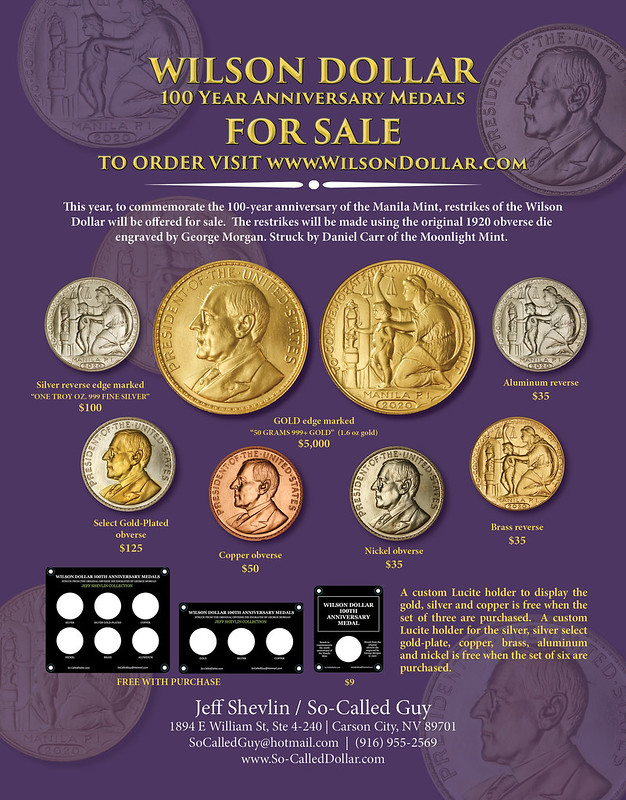
FRANCES MARIA KEELER MARSHALL (1810-1879)
John Lupia submitted the following information from the online draft of his book of numismatic biographies for this week's installment of his series. Thanks! As always, this is an excerpt with the full article and bibliography available online. This week's subject is about an early female U.S. numismatist, Mrs. Marshall. -Editor
Frances Maria Keeler Marshall (1810-1879), was born on November 22, 1810 at Kortright, New York, the daughter of Judge Martin Keeler (1781-1860), a native of Connecticut.
She married Dr. Robert S. Marshall, M.D. (-1850), on August 14, 1832 at the Presbyterian Church, South Kortright, New York. They had four children : Henry (1838-), Louisa Mary (1842-), Robert (1844-), and Helena (1850-).
They most probably built their house on the property purchased by Robert Marshall in 1834 at what is now designated as 48 Maple Avenue, Village of Hobart, Township of Stamford, Delaware County, New York.
Unfortunately, Dr. Marshall got bit by the gold bug after hearing the news of the "California Gold Rush" in 1849 and sailed there by boat. He got ill and died in California in November 1850 leaving his wife Frances a widow.
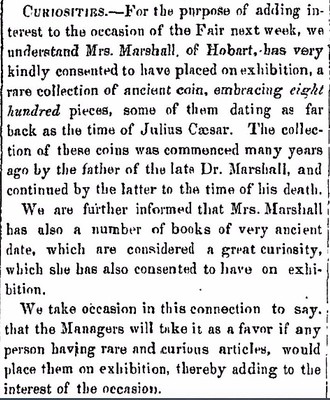 Mrs. Marshall collected United States, ancient, and foreign gold, silver, and copper coins, store cards, and medals continuing that started by her late husband. Dr. Marshall who received his medical degree in 1830 at New York, had inherited his father's coin collection, that of Dr. Henry Marshall (1775-1851), of Edinburgh, Scotland.
Mrs. Marshall collected United States, ancient, and foreign gold, silver, and copper coins, store cards, and medals continuing that started by her late husband. Dr. Marshall who received his medical degree in 1830 at New York, had inherited his father's coin collection, that of Dr. Henry Marshall (1775-1851), of Edinburgh, Scotland.
After the death of her husband Mrs. Marshall kept the 800 piece coin collection as a family heirloom and appears to have contributed to its expansion since it contains post 1850 material. Moreover, Dave Hirt discovered her name listed among the buyers in the Bangs, Merwin & Company sale of the Joseph Napoleon Tricot Levick (1828-1908) Collection sold from Saturday until Monday, May 27-29, 1865, having won several lots. She used to show her coin collection in viewing cases at the Delaware County Agricultural Fair held at Hobart from the 1850's through the 1870's.
In February 1864, The New York Times cites a "Mrs. Marshall" first among the Ladies Association working for "The Metropolitan Fair," for the benefit of the United States Sanitary Commission. Hence, another Fair Mrs. Marshall undoubtedly exhibited her coin cabinet.
Also, in 1864 she published A Catalogue of Coins of Mrs. Marshall, Hobart, N.Y. (9 pages with yellow wrappers) of her cabinet of coins in what some have interpreted to be a fixed price list and others as an auction catalogue. It was certainly printed in time for either "The Metropolitan Fair," or the annual Delaware County Agricultural Fair held at Hobart, perhaps, in the event anyone wished to purchase any specimen, or to hold a public auction. However, it seems also probable to have merely served as a fair souvenir catalogue for those who visited the fair and wanted to appreciate the collection and study the coins, although the words "For Sale" emblazoned on the cover certainly suggests something more than a mere exhibition. We know neither if the catalogue she printed was merely a master list from which she sold duplicates, an auction catalogue, nor if the cabinet of coins bequeathed in her last will and testament was of a different inventory from that published in 1864, nor whatever became of the collection after November 7, 1879.
A copy of Mrs. Marshall's, A Catalogue of Coins, has been scanned in the Newman Portal.
She died on March 14, 1879. Her will was probated on November 7, 1879 with Colonel Frederick Griffin, the late Robert Marshall's uncle as executor. Her cabinet of coins was bequeathed to her youngest child Helena Marshall. However, it was stipulated in the will that if Helena should sell the cabinet of coins the proceeds should be equally divided between herself, Louisa Barker (her married sister), and her two brothers Henry and Robert Marshall. Mrs. Marshall is buried in the South Kortright Cemetery.
To read the complete article, see:
MARSHALL, FRANCES MARIA KEELER
(http://www.numismaticmall.com/numismaticmall-com/marshall-frances-maria-keeler)
To read the earlier E-Sylum article, see:
THE MYSTERIOUS MRS. MARSHALL
(https://www.coinbooks.org/esylum_v19n23a11.html)
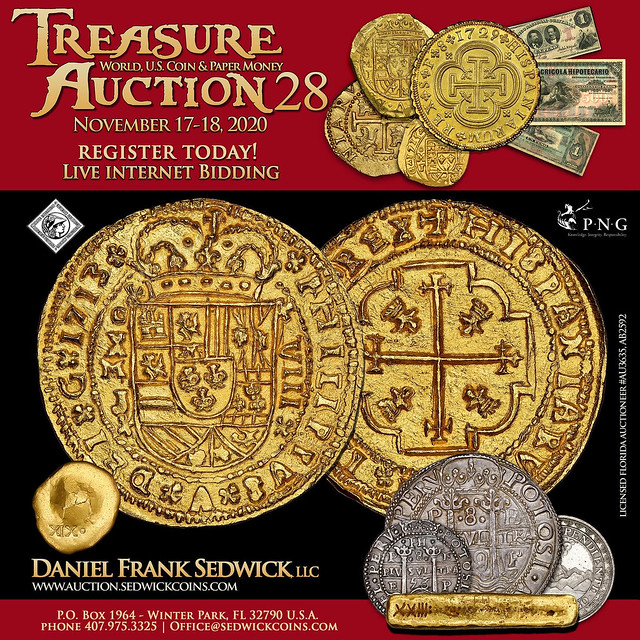
THE LEGENDARY COLLECTION OF WALDO NEWCOMER
Charles Morgan and Hubert Walker of CoinWeek published a nice article October 26, 2020 about the legendary collection of Waldo Newcomer of Baltimore, Maryland. Here's an excerpt, but be sure to read the complete article online. -Editor
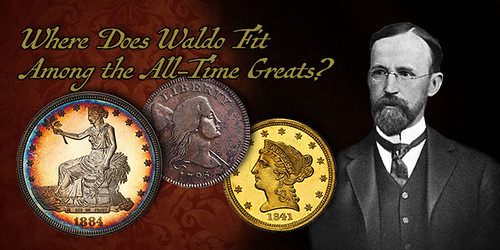
According to researcher George Fuld, who published a lengthy exploration into Newcomer's holdings between 2006 and 2008, the U.S. section of the collection was nearly complete, lacking only a single double eagle and the 1822 half eagle, of which only three are known. Fuld stated that Newcomer had a complete series of U.S. copper and silver coins. Helping Newcomer in assembling the collection was numismatist George Williams, who spent more than 20 years assisting in the effort.
Taking Fuld's research as accurate, that would put Newcomer's collection at or near the apex of all collections assembled in his time.
Seconding this opinion is PCGS, who in 2004 touched on Newcomer's achievement when it compiled a list of the 10 Most Famous U.S. Ultra Rarities for its Set Registry. In the PCGS list were many of the great story coins of American numismatics: the 1913 nickel; the 1894-S dime; the 1876-CC 20¢ piece; the 1838-O half dollar; the 1804 dollar; the 1870-S dollar; the 1885 Trade dollar; the $4 Stella; the 1907 Ultra High Relief Saint-Gaudens $20; and the 1927-D Saint.
Calling the Newcomer Collection the greatest collection never to appear at auction, it touted the fact that Newcomer's collection contained six of the 10. Missing was the $4 Stella and the two $20 Saints.
To read the complete article, see:
(https://coinweek.com/us-coins/where-does-waldo-newcomer-fit-among-the-all-time-great-collections-of-us-coins/)

OLYMPIC CHAMPION SWIMMER DARA TORRES MEDAL
The Jewish-American Hall of Fame has announced its latest inductee - Olympic gold medal Swimmer Dara Torres. A medal has been created in her honor. Here's the press release. -Editor
into the Jewish-American Hall of Fame
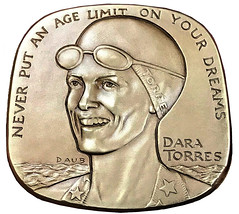
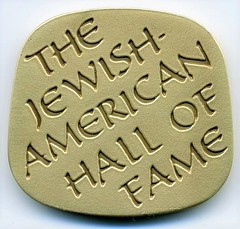
The Jewish-American Hall of Fame has inducted its first female sports star in 2020 - Olympic swimming champion Dara Torres. Torres competed in five Olympic Games, winning 12 medals. In her first Olympics, in 1984, she won a gold medal for the 100–meter relay. She went on to compete in the 1988, 1992, 2000, and 2008 Olympics, winning five medals in 2000, more than anyone else on her team. In 2008, the oldest–ever Olympic swimmer at age 41 (having given birth only a year earlier), won two silver medals for 100-meter medley relay and 50–meter freestyle, breaking the American freestyle record she had set at age fifteen.
Over the course of her career, Dara won four gold, four silver, and four bronze medals at the Olympics and broke the American record speeds for 50–meter freestyle ten times, more than any American swimmer in any event. Among multiple Olympic medalists, Dara is in 15th place worldwide (including both men and women), in 4th place among Americans, in 2nd place among American women, and in 1st place among all Jewish Americans.
Dara Torres entered her first international swimming competition at age 14. Over 20 years later, at the Beijing Olympic Games in 2008, Dara became the oldest swimmer to compete in the Olympic Games. When she took three silver medals home - including the 50-meter freestyle race where she missed the gold by a heartbreaking 1/100th of a second.
Dara was the first female athlete ever to be featured in the Sports Illustrated Swimsuit Issue, and in 2009, won the ESPY award for “Best Comeback.” To add to her accolades, Dara was also named one of the “Top Female Athletes of the Decade” by Sports Illustrated Magazine and, in 2019, she was inducted into the U.S. Olympic and Paralympic Hall of Fame.
A top-selling author, Dara Torres' memoir, “Age is Just a Number: Achieve Your Dreams at Any Stage in Your Life,” was published in April, 2009 and was listed as one of the top 25 best-selling business books later that year. Her second book, “Gold Medal Fitness: A Revolutionary 5-Week Program” hit stands in May, 2010 and became a New York Times Best-Seller.
The non-profit Jewish-American Hall of Fame has issued a limited number of large 2- inch, 3 oz. high relief art medals honoring Olympic multi-medal winner, swimmer Dara Torres, which will be given to contributors: 105 bronze ($50), 60 pure silver ($200), and 35 gold-plated pure silver ($250). Dara's likeness was created by the renowned American sculptor Eugene Daub - using an interesting sculpting technique reminiscent of ancient Egyptian sunken reliefs - whereas a portion of the portrait is below the surface and part of it is raised. Orders can be sent to JAHF, c/o Mel Wacks, 5189 Jeffdale Ave., Woodland Hills, CA 91364 or call 818-225-1348; E-Sylum readers can take 20% discount.
Another excellent medal in a marvelous, high-quality series. 50 years! See the earlier article for the book on the series honoring such greats as Albert Einstein, Ruth Bader Ginsburg, Hank Greenberg, Houdini, Golda Meir, Joseph Pulitzer, Jonas Salk, Haym Salomon, Barbra Streisand, and many more. -Editor
To read the earlier E-Sylum article, see:
NEW BOOK: JEWISH-AMERICAN HALL OF FAME MEDALS
(https://www.coinbooks.org/v23/esylum_v23n10a06.html)
For more information on the Jewish-American Hall of Fame, see:
http://www.amuseum.org/jahf/
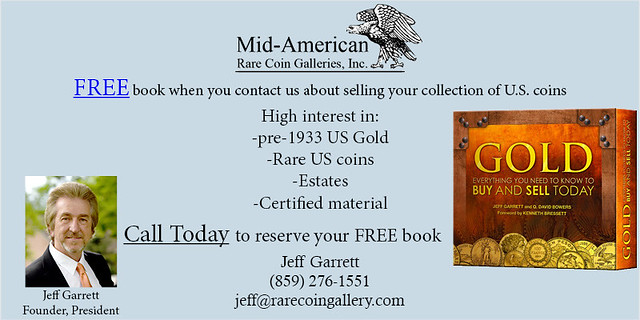
CUSTOM AUGMENTED REALITY BANKNOTES OFFERED
This press release announces a whole new way to look at banknotes. Not the government-issued kind, but privately issued souvenir and event documents. See the demo videos online for the full experience. -Editor
Money Talks (And Sings, Dances, Or Spits Fire) with New Augmented Reality App from International Banknote Printer Royal Joh. Enschedé
This is the concept behind a custom designed banknote containing a new augmented reality (AR) app offered by Royal Joh. Enschedé, the 300-year-old globally renowned printer of banknotes, stamps and other security documents.
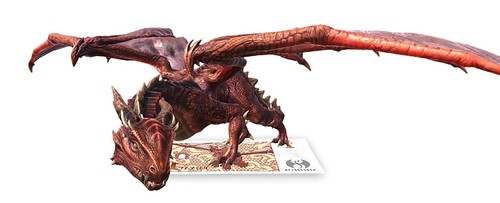
Load the app from the website and scan the banknote to enjoy a unique interactive fan experience. The banknotes are printed on genuine banknote paper containing security features only found in currency. Special printing inks and Intaglio printing is used to guarantee the genuine "feel" of money. Notes can be available for purchase using our own ATM's.
“The possibilities for customization are endless. Currency-like banknotes can be embedded with exclusive sales or discounts, make a game out it by adding 'hidden' elements, offer a prize or gift, Holiday Notes, encourage participation in a sweepstakes, issued as Limited Edition collectibles, or used as a revenue generator for sports, entertainment, education and even Fun Raising,” says Gelmer Leibbrandt, CEO, Royal Joh. Enschedé in Haarlem, Netherlands.
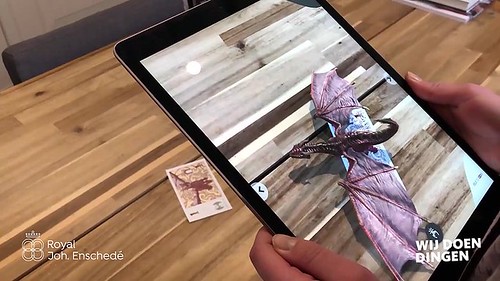
Founded in the Netherlands in 1703, Royal Joh. Enschedé is regarded as the worldwide leader in security printing. In addition to traditional printing of banknotes, stamps and security documents such as visa, tax and certificates, is an innovator in currency technology, as this new app shows. Royal Joh. Enschedé's Design Team includes banknote artists, engravers, and paper money security experts, as well as former U.S. Treasury artists and engravers.
Check it out - click the "Watch Demo" button at the top of the page linked below.
Will augmented reality ever become a feature of officially-issued government banknotes? Perhaps. Private companies are often in the forefront of new money minting and printing technologies, from goldsmith's receipts that traded as money, Boulton's Soho Mint that transformed Britain's coinage to today's mobile phone payment apps. -Editor
To learn more, visit:
www.YourOwnCurrency.com
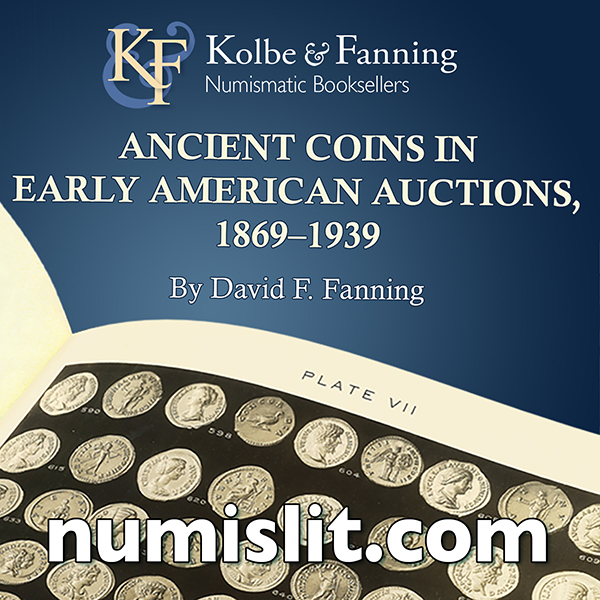
PAN FALL 2020 SHOW SUCCEEDS DESPITE PANDEMIC
Until nearly the last minute, organizers of the Pennsylvania Association of Numismatists fall 2020 show couldn't be sure local authorities would allow the event to be held. They planned ahead nevertheless, but couldn't even contract the usual advertising in the usual local and national publications due to the uncertainty. Yet the event was indeed held, and was a success on all fronts. Kudos to PAN and everyone involved, including the dealers and public who were quite compliant and supportive overall, cooperating with little grumbling amid all the necessary health precautions. Here are some photos and a few early comments from attendees. -Editor
PAN Corresponding Secretary Pat McBride writes:
"Any photos without masks were for a few seconds only. It went extremely well. Attendance did not fall off due to Covid. Amazing cooperation with forms and masks. All dealers reported a great show. They loved the setup at the larger North Hall."
Tom Uram writes:
"A couple dealers said it was their best show in years. It went extremely smooth. Spirits were positive."
Bill Bierly writes:
"I thought the PAN show went very well. The dealer tables were sold out and all dealers I spoke with were having a good show. The exhibit area was somewhat curtailed but was nice. Personally I found two nice LaPorte, Indiana Civil War tokens so deemed the show a success. I also sold a few of my books."
Setup
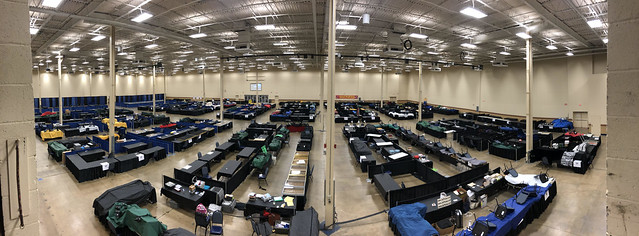
Extra wide aisles in the larger North Hall
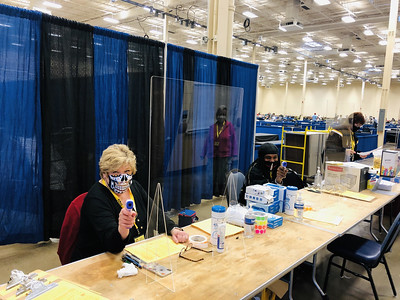
That's the registration desk, not a health clinic
Stick 'em up! All attendees were temperature-checked and questioned daily, with color-coded registration forms and badge stickers each day.
Bourse Floor
Here are some views of the bourse floor.
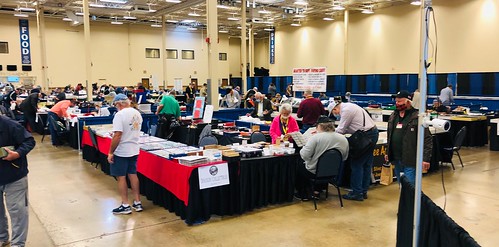
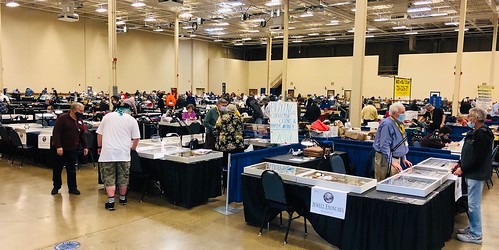
Bill Bierly
Author Bill Bierly attended with copies of his new Whitman book In God We Trust.
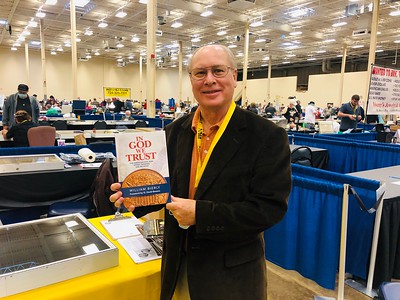
John Frost Lectures
John Frost gave two presentations on Barber and Liberty Seated coinage.
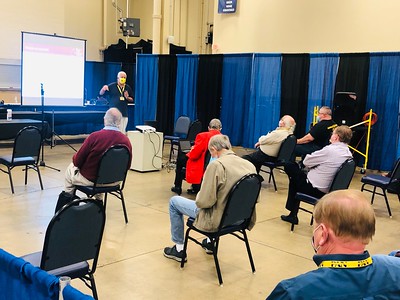
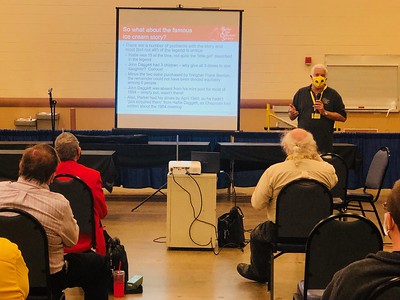
Ben Franklin's Show Purchase
Pat McBride attended in his role as Benjamin Franklin.
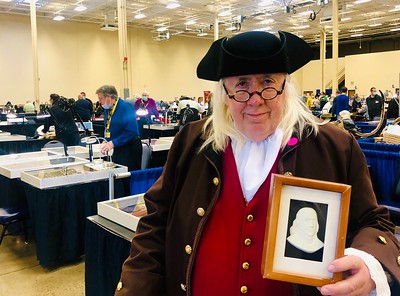
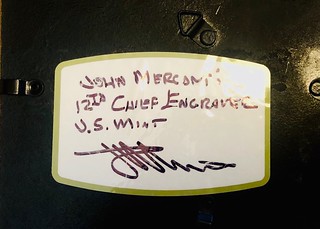
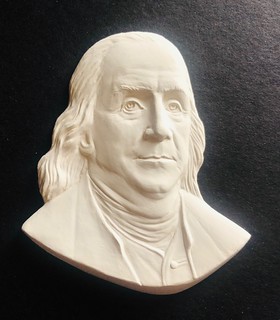
Ben writes:
"Yes, I did buy something at the PAN show. I have personally met both messieurs Rittenhouse and Mercanti."
To view a photo gallery on Flickr, see:
PAN 2020 Fall Show During Pandemic
(https://www.flickr.com/photos/coinbooks/albums/72157716709244872)
For more information on PAN, see:
https://pancoins.org/
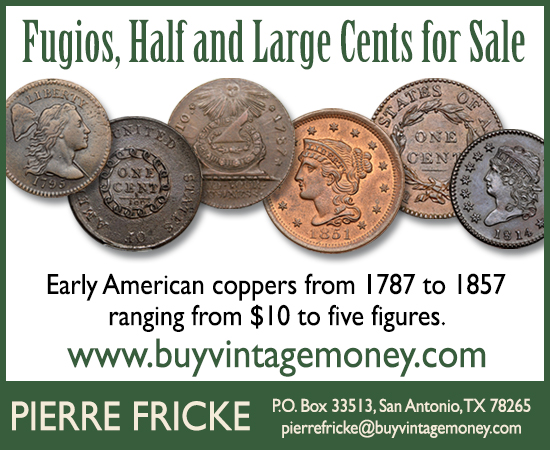
COLTRANE COLLECTION PART I U. S. CURRENCY PREVIEW
Stu Levine, Bruce Hagen, and Maureen Levine submitted this preview of additional U.S. paper money lots in the upcoming Heritage sale of the Mike Coltrane Collection, Part 1. Thanks! -Editor
U. S. Currency Preview
In the past few issues we previewed many of the great rarities in The Mike Coltrane Collection Part 1. It's a fascinating grouping, with notes spanning virtually all genres of U.S. currency: Colonial notes, Continental Currency, War of 1812 Treasury Notes (the first portion of the finest collection ever assembled) as well as Federal large and small size issues. Many of these pieces have been off the market for decades and are all offered completely unreserved. An eclectic sampling is below:
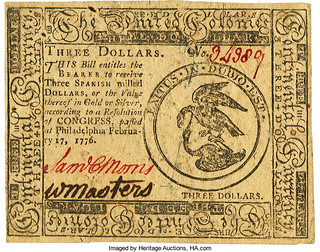

Continental Currency February 17, 1776 $3 Fr. CC-25 PMG Choice Uncirculated 64 EPQ
This top-grade Continental shows Benjamin Franklin's emblem of the eagle and heron fighting on the face and an excellently detailed Franklin nature print back. Lot 25012.
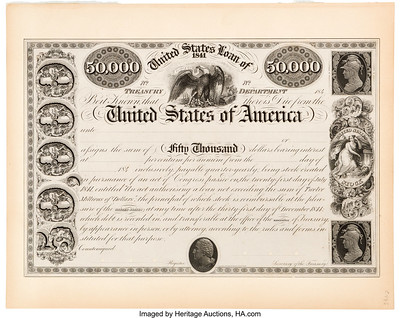
United States - Act of July 21, 1841 $50,000 "United States Loan of 1841" Registered Bond. Hessler X104I. Proof. PMG Choice Uncirculated 63
One of the highest-denomination Federal bond proofs we have seen. It was the equivalent of 5,000 gold eagles—an immense sum. Ex: Vattemare Collection and unique. Lot 25036.
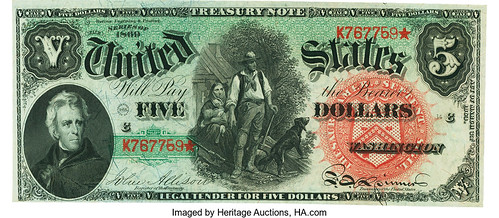
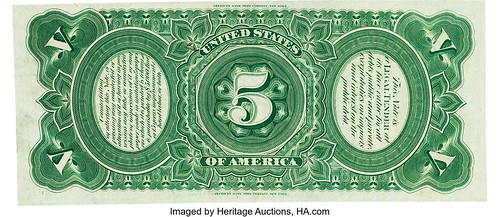
Fr. 64 $5 1869 Legal Tender PMG Choice Uncirculated 64 EPQ
Mike bought his 1869 $5 “Rainbow” legal tender note in 1984; off the market for decades, it is certified for the first time. Lot 25075.
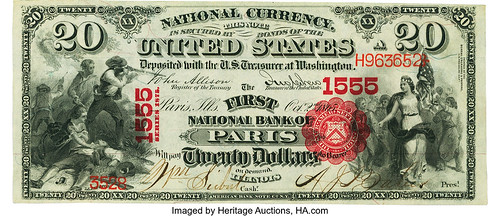
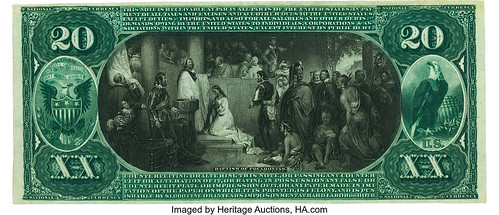
Paris, IL - $20 1875 Fr. 431 The First National Bank Ch. # 1555 PMG Choice Uncirculated 64
One of the most beautiful National Bank note types. Strongly printed on both sides, especially the intense green back with the Baptism of Pocahontas. Lot 25189 .
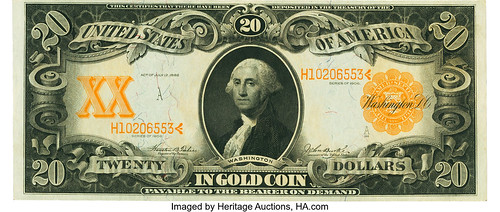
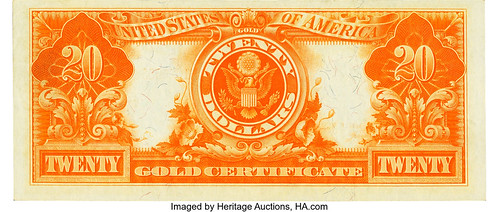
Fr. 1186 $20 1906 Gold Certificate PMG Gem Uncirculated 65 EPQ
Mike enjoys gold notes with dazzling orange backs. He bought this in 1989 from the very discerning Frank Nowak. Lot 25258.
We hope you will take the time to peruse this important offering. All lots are currently on view at HA.com/3575. Session 1 (floor) of Mike's important collection, featuring 282 lots, will take place on Wednesday, November 4, 2020, at 5:00 PM Central Time in Dallas. The Heritage Live (online only) Session 2, with an additional 202 Federal currency lots, will commence at 10:00 AM Central Time on Thursday, November 5, 2020. Lot viewing is available by appointment only at Heritage's Office in Dallas; contact Jose Berumen at JBerumen@ha.com or 214-409- 1299.
To read the earlier E-Sylum articles, see:
COLTRANE COLLECTION SELECTIONS PART 1
(https://www.coinbooks.org/v23/esylum_v23n41a22.html)
COLTRANE COLLECTION SELECTIONS: BACK DESIGNS
(https://www.coinbooks.org/v23/esylum_v23n42a25.html)
COLTRANE WAR OF 1812 TREASURY NOTES
(https://www.coinbooks.org/v23/esylum_v23n43a25.html)

DANIEL FRANK SEDWICK AUCTION 28 ANNOUNCED
Here's the announcement for the upcoming auction sale by Daniel Frank Sedwick, LLC. Great variety of nice coins, medals and paper money. Be sure to check out the full catalog online. -Editor
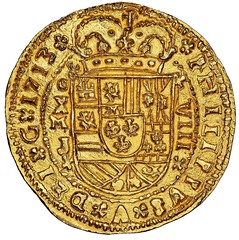
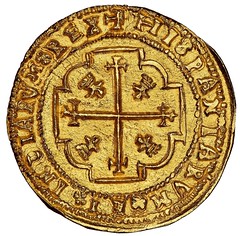
Lot 21
This time we are doing something different by beginning the Gold Cobs section with those from mainland Spain before moving to gold cobs of the New World. It is here you'll see the extremely rare and gorgeous 1713J Mexico cob 8 escudos Royal graded NGC MS 66 from the Corrigan's wreck site of the 1715 Fleet (lot 21), its first appearance at auction and our first time offering a type considered to be the pinnacle of Spanish colonial numismatics. Clyde Kuntz, the diver who discovered the coin in 1998, will be speaking online the day prior to the auction about his experience of finding a coin "made for a king." Following Mexico is a selection of some of the choicest Lima gold cobs ever seen from the 1715 Fleet, in addition to gold cobs from all the other South American mints that made them.
Next we offer a number of historical Shipwreck Ingots, most notably a variety of New World treasure ingots from the "Tumbaga wreck" of ca. 1528 (including lot 68, a very rare gold "tumbaga" bar) and the "Golden Fleece wreck" of ca. 1550. Atocha collectors will want to watch for an intriguing gold "church" bar (lot 71) along with three of the ever-popular large silver bars (lots 82-84).
Four centuries' worth of Shipwreck Coins are up for bid next, from the iconic Atocha (1622) and 1715 Fleet-recovered cobs to United States shipwreck finds like an 1863-S $20 double eagle from the Brother Jonathan (lot 383).
It is our privilege to offer in this auction the Dr. Peter Jones Collection of Early Coinage of the Americas, illustrating the many different types of coins created in the New World. In his latest book, The First Coins of the Americas, Dr. Jones documents his collection and its connection to historical events during American colonization; his online talk the day before the auction will describe his journey across decades of collecting. His selection of rare Charles-Joanna coinage in Mexico Silver Cobs is particularly noteworthy, featuring trophies like a Mexico City 3 reales of assayer Rincon (lot 429), along with several rare "Early Series" types.
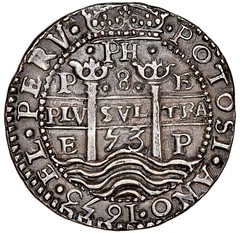
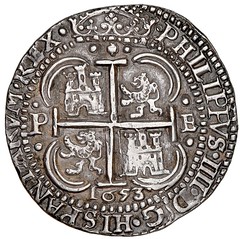
Lot 595
In our most significant offering of cob Royals to date, highlights in Mexico Silver Cobs include a unique 1713J cob 8 reales Royal (lot 501) as well as a very rare 1615/4F cob 8 reales Royal (lot 490), in addition to some unique minor-size Royals and some in Lima Silver Cobs as well. Continuing that theme, in Potosí Silver Cobs we feature the Royal Collection of some of the finest and rarest Potosí galanos from all the different kings, including the finest-graded 1653E cob 8 reales Royal (lot 595), pedigreed to the famous "Americas" collection) along with an NGC star-designated and very beautiful 1669E cob 8 reales Royal plated in Sellschopp (lot 598). Other Silver Cobs contains several elusive Santo Domingo Charles-Joanna cobs (lots 646, 647 and 648) and a rare Panama cob 2 reales of Philip II (lot 651).
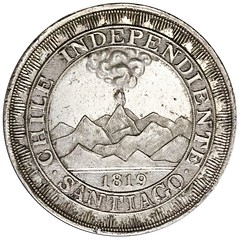
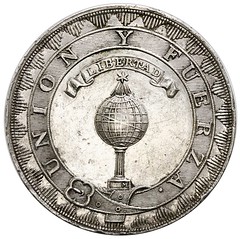
Lot 751
In World Coins are many Spanish and Latin American rarities like the important Chile 1819 pattern peso (lot 751) and the finest-graded Seville, Spain, 1729P gold milled 8 escudos (lot 1176), along with many desirable rarities from Costa Rica, Ecuador, and Honduras. Worldwide, other key coins up for bidding are an Ethiopia EE1892 (1900) matte proof birr of Menelik II (lot 839), a Japanese gold koban from the Hoei/Shotoku era (lot 1062), and a pair of certified Lahore-mint (British India) silver original proof 1943-L ½ and ¼ rupees (lots 1056-1057). The Zeitlos Collection of German States Coinage hosts many desirable German type-coins, including a possibly unique Nassau-Weilburg 1812-L/CT "old bust" taler (lot 921) and several finest-certified Bavarian commemorative talers.
Medals and Decorations features Selections from the John Adams Collection of Admiral Vernon Medals, a couple of which are plated in his reference work on the series. Other medals in this section include a large and impressive Colombian gold medal commemorating the Panama Canal project (lot 1216) and an original Great Britain silver medal from 1687 depicting the recovery of the Concepcion shipwreck treasure (lot 1221).
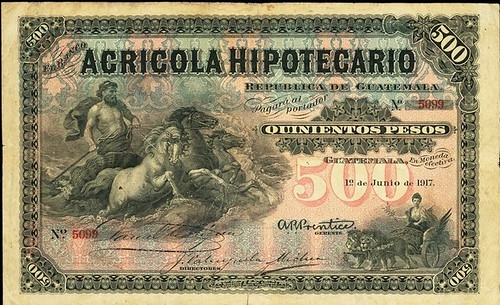
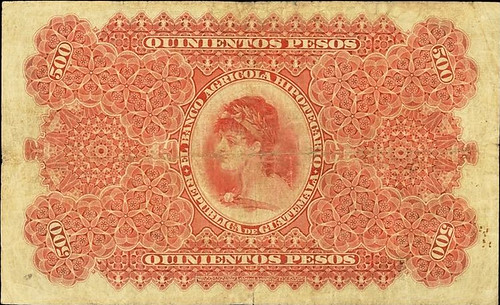
Lot 1298
U.S. Coins and Paper Money presents several pieces of early American currency, like a choice 1787 Fugio cent (lot 1272) and a 1776 Continental Congress-issued $7 note (lot 1277). Sure to attract attention in World Paper Money are Guatemalan rarities like the only certified 1917 Banco Agrícola Hipotecario 500 pesos (lot 1298) and a "top pop" 1945 Banco Central 20 quetzales (lot 1294).
The Coin Jewelry section offers up our largest selection to date of fashionable coin designs, like ancient Athenian owl tetradrachms, Julius Caesar's elephant denarius, and cobs from shipwrecks and other sources, all ready to wear.
The Shipwreck Artifacts section contains a timeline of objects, including a long Spanish colonial gold chain of 277 solid links salvaged from the Santa Margarita (lot 1367), a large and complete Nuremberg nesting cup-weight set from the Dutch East Indiaman Merestein (lot 1372), some Civil War-era American bottles from the S.S. Republic (lots 1384-1389), a sealed bottle of beer from the Empress of Ireland (lot 1390), and various dinner service pieces from 20th-century ocean liners S.S. Medina, S.S. Aurania, and Andrea Doria. Non-Wreck Artifacts presents a mixture of historical objects, like 44-million-year-old insects preserved in amber lots (1408-1409), cannons and cannonballs, swords and flintlock pistols, and other miscellaneous antiques. Some Titanic survivor-signed postcards highlight our Documents section at the end.
As usual, on the last day we hold an Express session with additional coins, medals, bank notes, and artifacts at lower estimates for the wholesale- or budget-minded. We wish you all best of luck in the auction and hope you find many new acquisitions for your collection. Be healthy, everyone!
For more information, or to bid, see:
https://auction.sedwickcoins.com/Treasure-World-U-S-Coin-Paper-Money-Auction-28_a43787
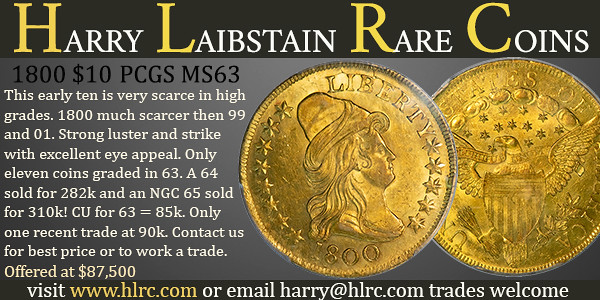
NUMISMATIC AUCTIONS LLC SALE 65 CATALOG READY
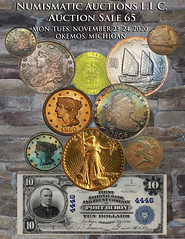
The catalog for the Numismatic Auctions LLC sale 65 is online and available for viewing or download. The sale will be held November 23-24, 2020. Here are some lots that caught my eye - see the catalog and the earlier article for highlights. -Editor
Lot 3: North West Company Token
North West Company Token, 1820. Brass. Breen-1083. PCGS
Genuine, VF details, Environmental Damage and holed. Only a
handful of these exist unholed or unimpaired. Red Book listed and
always in demand, a legendary numismatic relic of the fur trade, the
Hudson Bay Company and Native American commerce. Rare.
Great, historic piece. -Editor
Lot 20: 1841 Proof Half Cent
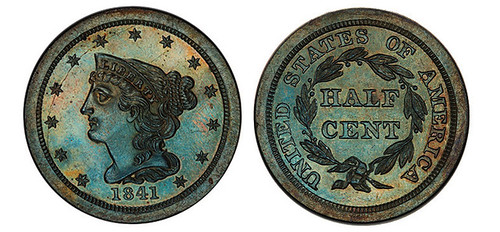
Extraordinarily Choice 1841 Proof Half Cent Rarity. 1841 Braided Hair Original Proof PCGS Gold Shield PR64BN CAC. Exquisite glass-like mirrored fields with stunning iridescent steel to teal blue toning. Prohibitively rare with a reported mintage of only 24 pieces, with the few surviving examples nowhere near this superb state of preservation. An investment quality rarity for the advanced US collector or copper specialist, well deserving of its CAC designation
See Bill Eckberg's cover article on this month's Numismatist. The Half Cents are a great series to collect. -Editor
Lot 193: 1795 Half Dime
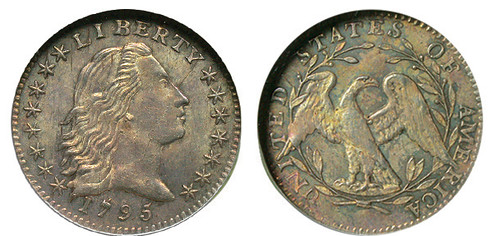
Magnificent Original Mint State Silver Half Dime. 1795. Flowing Hair. LM-8. NGC MS65 with lovely blue-green to golden-gunmetal toning. A beautiful and fully original Mint State Gem of this rare Federal Period Silver minor coinage type, certainly CAC worthy based upon originality alone.
Wow - a great early type coin. -Editor
Lot 926: 1901-S $5 gold
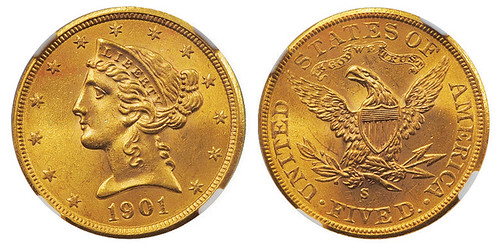
5 Dollars, 1901-S. NGC MS64, nice cartwheel luster with splashes of pale violet.
Nice coin. I'm not above being drawn to nice shiny stuff. -Editor
Lot 1116: Hawaii Hobron Token
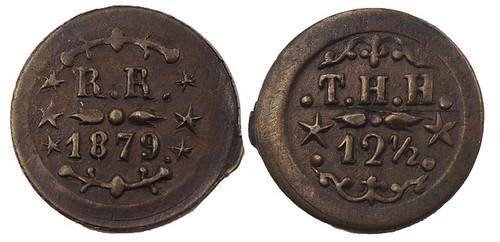
12 ½ Cents Thomas H. Hobron Token, 1879. Handsome brown EF and quite pleasing. Very scarce.
Hawaii tokens are scarce but there are few known types and varieties, so it's a doable state set to put together. -Editor
Lot 1329: 1891 $2 Bill
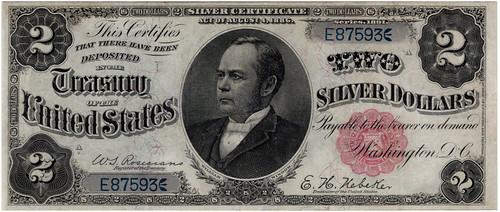
$2, 1891. Fr. 245. PMG VF25 minor repairs noted, expertly executed and very well-concealed.
A seldom-seen (at least by me) type note. I like how the denomination "2" in the lower right corner is tilted at a jaunty angle, along with the undulating curves of the phrase "United States Silver Dollars". -Editor
Lot 1350: 1900 $10,000 Bill
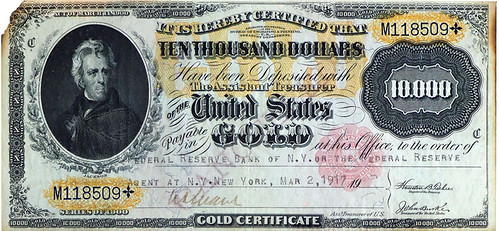
$10,000, 1900. Fr. 1225h. A seldom offered signature pairing with the added bonus of the note being Uncancelled. Appearance of aEF to EF, cpl singed corners from the legendary DC fire provide both credibility and presence to the note, overall nice with transfer endorsement verso. An always popular and impressive high denom issue as well as an affordable trophy note. Housed in an oversized Capital Plastics display holder.
If you can't afford a Warhol "Red Shot Marilyn", the burnt $10,000 bill is an equally storied collectible. -Editor
Lot 1455: Potty Dollar and Potty Dime
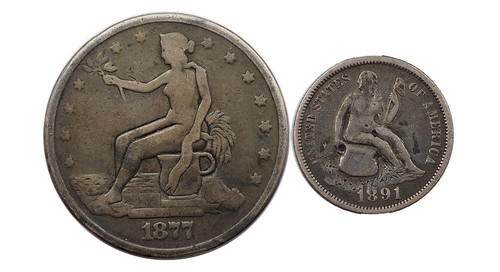
1877 “Potty Dollar” engraved in slightly finer style than the preceding example on a chamber pot resembling a coffee cup with ribbon above. Host coin full rim Good-VG and toned, cpl old marks. Always sought after, accompanied by a seldom seen “Potty Dime”, 1891, toned Fine/VF. 2 coins. ($250-300)
I've seen potty dollars, but wasn't familiar with the potty dime. Neat pair. -Editor
Lot 1487: Thomas Elder 1927 Gold Token
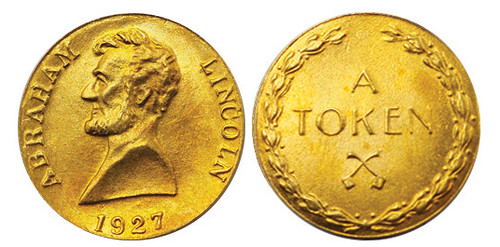
Lincoln Gold Token, 1927. AV, 15mm. As DeLorey-48. Unc, with auction ticket from the Litman, Sullivan & Dreyfuss Collection Sale at Presidential. ($200-300)
Lot 1503: Pedley-Ryan Dollar
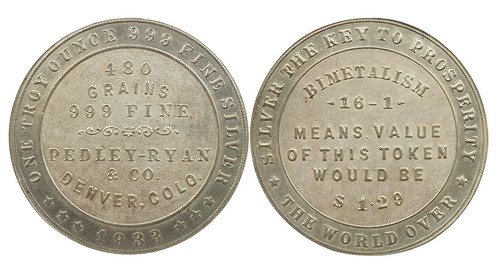
Pedley-Ryan Dollar, 1933. Type VII. HK-828. PCGS Gold Shield MS64. A handsome example of this R7 rarity at the very top of the condition spectrum available. ($3500-4000)
Nice example of a great rarity. -Editor
To read the full catalog, see:
Sale 65 Session One US Coins to Gold Lots 1-1042 (pdf)
Sale 65 Session One US Commems, Paper and Exonumia Lots 1043-1507 (pdf)
Sale 65 Session Two World Gold to World Coins and Exonumia Lots 1508-2216 (pdf)
To read the earlier E-Sylum articles, see:
NUMISMATIC AUCTIONS LLC SALE 65
(https://www.coinbooks.org/v23/esylum_v23n37a26.html)
WASHINGTON QUARTER AND PEACE DOLLAR PLASTERS
(https://www.coinbooks.org/v23/esylum_v23n40a22.html)
THE BOOK BAZARRE
NUMISMATIC NUGGETS: NOVEMBER 1, 2020
Here's a selection of interesting or unusual items I came across in the marketplace this week. Tell us what you think of some of these. -Editor
Gaul Euburovices Hemistater
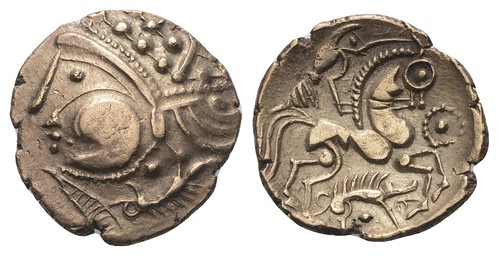
Gaul. Euburovices.
Hemistater (gold). Approx. 110-50 BC BC
Vs: stylized head on the left.
Rs: rider on horseback galloping to the right, boar below.
18 mm. 2.94 g.
I love these stylized designs. From the Solidus Auction 66. -Editor
To read the complete lot description, see:
Lot 2
Gaul. Euburovices.
(https://solidus-numismatik.auex.de/Auktion/Onlinekatalog?intAuktionsId=980)
1705 Peter I Beard Token
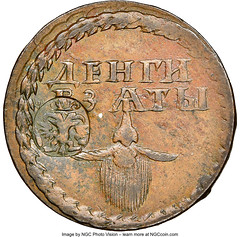
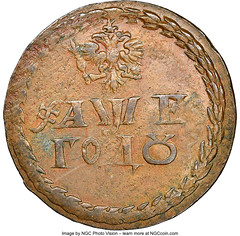
Peter I copper Beard Token 1705 AU55 Brown NGC, Bit-3893 (R2), Rudenko-2, Brekke-3. 'Narrow Beard' type, with countermark. Counterstamp graded AU Standard. Issued as a receipt for Peter the Great's 'beard tax.' Following his travels to Europe, where he encountered far fewer men sporting facial hair, the Czar ordered all Russian men shave their beards. As this caused great consternation, a compromise was achieved by allowing men to keep their facial hair through the payment of an annual tax. Proof of payment was conveyed through carrying one of these tokens as a form of receipt. Light and even wear over chocolaty brown surfaces. Very scarce so fine.
A great Russian bread token in the Heritage sale of the Charles J. Opitz Collection. -Editor
To read the complete lot description, see:
Russia: Peter I copper Beard Token 1705 AU55 Brown NGC,
(https://coins.ha.com/itm/russia/russia-peter-i-copper-beard-token-1705-au55-brown-ngc-/a/3088-35087.s)
1868 Proof Eagle
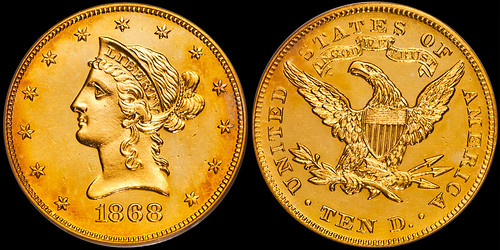
Every Liberty Head eagle struck prior to 1880 is very rare in Proof, but many of the issues from the 1860s and 1870s are extreme rarities. The 1868 is clearly one of these. Of the 25 struck, there are likely not more than seven or eight known and this includes at least two pieces which are impounded in museum collections. Interestingly, no Proofs of this date have appeared at a major public auction sale since this exact coin (see below for more information) was auctioned in 2006.
I came across this great proof eagle in the stock of E-Sylum supporter Doug Winter. -Editor
To read the complete lot description, see:
https://raregoldcoins.com/rare-gold-coin-inventory
1931 Paris Colonial Exhibition Amerique Medal
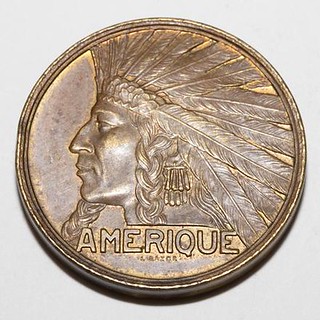
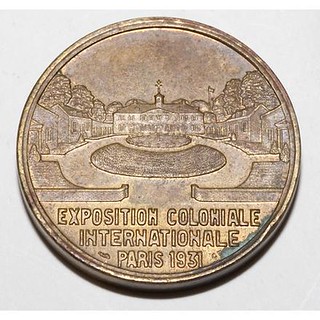
France Bronze Medal - Exposition Coloniale Internationale Obv - AMERIQUE Indian Head left Reverse - Exposition Coloniale / Internationale /Paris 1931.
Interesting America-themed medal from the November 18th, 2020 Alex Cooper sale. -Editor
To read the complete lot description, see:
1931 PARIS COLONIAL EXHIBITION AMERIQUE MEDAL XF
(https://bid.alexcooper.com/lots/view/1-3QUEZ4/1931-paris-colonial-exhibition-amerique-medal-xf-)

GOLD IDES OF MARCH COIN REALISES $4M
The gold "Ides of March" coin sold this week for over four million dollars and generated news coverage around the world. Dave Sundman was the first to share the news with this article from The Sunday Times. -Editor
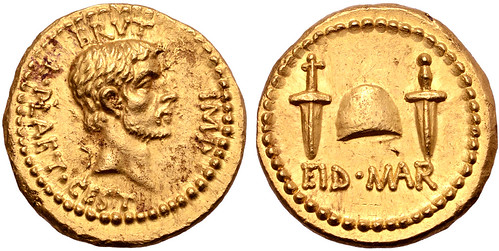
A gold coin issued by Brutus and described as a “naked and shameless” celebration of the assassination of Julius Caesar has sold for £3.2 million, a record for an ancient coin.
The gold aureus, which depicts the daggers of Marcus Junius Brutus and his fellow assassin Cassius, with the inscription EID MAR — for the ides of March, the date of the murder — is one of only three of its kind known. The others are on long-term loan to the British Museum and in the collection of the German Federal Bank.
It was struck in the summer or autumn of 42BC by a military mint travelling with the forces of Brutus and Cassius shortly before their defeat by Mark Antony and Octavian at the Battle of Philippi in Macedonia.
The coin had a presale estimate of £500,000 but sold for £2.7 million, with a buyer's premium of 20 per cent added after.
To read the complete article (subscription required), see:
Julius Caesar assassination coin sells for record amount
(https://www.thetimes.co.uk/article/julius-caesar-assassination-coin-sells-for-record-2-7m-806868rt9)
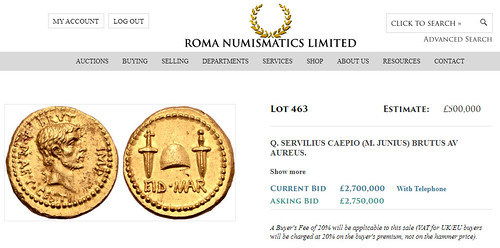
Kavan Ratnatunga watched the auction live, and provided the above screenshot of the end result. Thanks! Thanks also to Dick Hanscom and others for links to other coverage of the event. Note that prices shown vary based on rounding and whether the quote is in dollars or pounds, or includes or excludes buyer's fee. The name of the winning bidder has not yet been revealed. -Editor
To read other articles, see:
BCE Caesar Assassination Coin Sold at Auction for $ 3.5 Million
(https://pledgetimes.com/bce-caesar-assassination-coin-sold-at-auction-for-3-5-million/)
Roman gold coin commemorating the assassination of Julius Caesar 2,000 years ago sells for a record £3.24 MILLION at auction
(https://www.dailymail.co.uk/sciencetech/article-8896741/Antiques-Roman-gold-coin-commemorating-assassination-Caesar-sells-record-3-24-MILLION.html)
Roman coin authenticated in Sarasota area sets world record at auction
(https://www.heraldtribune.com/story/news/2020/10/30/roman-coin-authenticated-sarasota-area-sets-world-record-auction/6083534002/)
Note that in 2020, the gold EID MAR displayed at the British Museum was thought to be unique. Here are links to some earlier E-Sylum articles. -Editor
To read earlier E-Sylum articles, see:
BRITISH MUSEUM DISPLAYS UNIQUE GOLD EID MAR COIN
(https://www.coinbooks.org/esylum_v13n12a24.html)
GOLD IDES OF MARCH COIN OFFERED
(https://www.coinbooks.org/v23/esylum_v23n41a25.html)
DAVID VAGI GOLD IDES OF MARCH COIN INTERVIEW
(https://www.coinbooks.org/v23/esylum_v23n42a28.html)
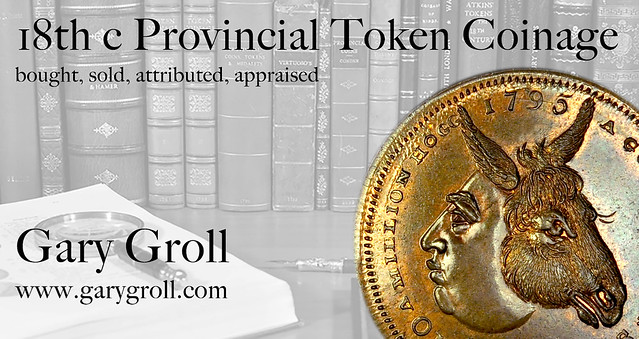
ELIZABETH I GOLD SOVEREIGN
This Heritage press release highlights an Elizabeth I gold sovereign. Nice coin! -Editor
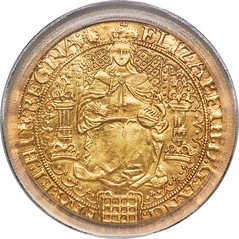
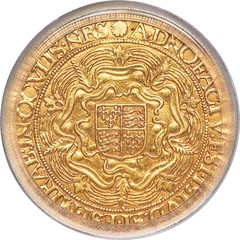
A 430+ Year Old Coin Fit For the Queen (And Her Favorite Nobles)
Most coins that you have in your pocket today are average at best--pedestrian pieces of commerce that can be owned by nearly anyone. However, Heritage will be offering a coin in the October World Coin Auction #3088 that was fit for a queen (and her most trusted nobles). The piece in question is a very special Queen Elizabeth I gold Sovereign that was minted between 1584 and 1586. This oversized gold coin will immediately catch your attention and has an impressive portrait of the Virgin Queen on the obverse as well as the famous Tudor rose on the reverse. Graded AU details by PCGS, this coin will attract significant attention when it crosses the auction block.
During the reign of Queen Elizabeth I, the typical British citizen would never have the opportunity to see a special piece like this in person. Sovereigns were almost never seen beyond noble circles and changed hands infrequently, used mainly for display purposes at Court rather than day-to-day commerce. These coins were sometimes given as gifts to reward the Queen's favorites or those who earned her respect. They would have been saved and cared for by the recipients rather than being spent right away.
Unlike many debased coins of the period which did not have pure precious metal content and earned the public's distrust as a result, this Elizabethan coin made a bold statement by being produced in nearly pure gold. Its intrinsic quality as well as its design really stood out at the time (and continue to impress collectors today.) Given the periods of economic distress that had led to English rulers debasing their coinage, striking these coins with such a reliable gold content sent a message of Queen Elizabeth's power and intentions to her people.
Coins also served as a form of pictorial propaganda during a period when information did not spread as quickly as it does today. The gold sovereigns of Queen Elizabeth became an emblem of power and wealth for the holder, broadcasting a message about both the Queen and her trusted nobles. The obverse shows the Queen holding the scepter and orb--equally impressive today as it would have been at the time it was minted over 400 years ago.
This coin will be a true prize for the collector who acquires it at auction, just as it would have been a special piece for its original owner in the late 1500s.
To read the complete lot description, see:
Great Britain: Elizabeth I (1558-1603) gold Sovereign of 30 Shillings ND (1584-1586) AU Details (Repaired) PCGS,
(https://coins.ha.com/itm/great-britain/great-britain-elizabeth-i-1558-1603-gold-sovereign-of-30-shillings-nd-1584-1586-au-details-repaired-pcgs-/a/3088-33133.s)

ENGLAND'S FIRST MILLED CROWN
Another Heritage press release highlights an Oliver Cromwell Crown in their November 5-6 sale. -Editor
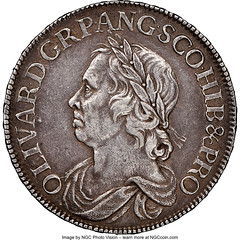
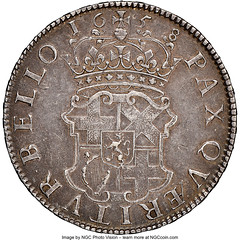
England's First Milled Crown
Milled coinage, or machine-struck coinage, ushered in an era of new technology for minting in England. It is used to describe coins that are struck by machine rather than hammered by hand, and the difference in quality of production is clear when you compare an older hammered piece with the newer quality available with milled pieces. These coins, struck in the 1650s, were novel at the time and revealed the best of new technology in the British Isles.
England's first milled crown brings to mind an unpopular and controversial ruler: Oliver Cromwell. The English Civil War ended in 1649 on the execution of King Charles I, marking the beginning of the Commonwealth of England presided over by Oliver Cromwell, its Lord Protector. A staunch Puritan, Cromwell soon set about transforming the face of the land by his ideals, including canceling Christmas celebrations!
Cromwell is remembering for hating what he considered to be 'decadence' as well as the monarchy. He even refused the crown when it was offered to him. This Puritan and anti-monarchist feeling is generally visible in the coins of the Commonwealth period, which bore no likeness of a King or Queen, had English legends instead of Latin, and were generally quite plain compared to earlier issues.
Cromwell's coinage is often remembered both as the first English currency to portray a commoner rather than a King or Queen. However, a close observer will also notice that despite his claims to have done away with the monarchy, the arms on the reverse of these coins continued to display a crown!
Heritage will be offering a 1658/7 Overdate Cromwell Crown as part of the October World Coin Auction #3088. Graded XF45 by NGC, these pieces are very popular as the first milled crown. They were designed by the man widely regarded as England's finest engraver of all time, Thomas Simon. However, this act had consequences for Simon--it lost him all favor with King Charles II when the royal Restoration occurred in 1660. The hammer method of minting returned briefly (1660-62), but in terms of quality, the milled pieces of Cromwell were clearly superior.
To read the complete lot description, see:
Great Britain: Oliver Cromwell Crown 1658/7 XF45 NGC,...
(https://coins.ha.com/itm/great-britain/great-britain-oliver-cromwell-crown-1658-7-xf45-ngc-/a/3088-34719.s)

THE CROW, THE PITCHER, AND THE PEBBLE
Maureen Levine writes:
"In working on the upcoming Mike Coltrane North Carolina currency internet sale at Heritage Auctions, I did some research on the crow and pitcher vignette, one of the eight different types on the $1/2 Halifax series notes. To my knowledge, the origin and meaning of that vignette has not been discussed previously."
Maureen submitted the following article. Thank you! Images courtesy Heritage Auctions. -Editor
 What is the significance of the "crow and pitcher" vignette on the Halifax issue of North
Carolina currency, and where did the image originate? Unlike the Franklin motifs on Continental
Currency, it won't be found in arcane books of symbols and emblems. Instead, the source is
Aesop's fables, which were very popular in Colonial America. Thomas Jefferson referred to
various tales on more than one occasion, using them to illuminate current events.
What is the significance of the "crow and pitcher" vignette on the Halifax issue of North
Carolina currency, and where did the image originate? Unlike the Franklin motifs on Continental
Currency, it won't be found in arcane books of symbols and emblems. Instead, the source is
Aesop's fables, which were very popular in Colonial America. Thomas Jefferson referred to
various tales on more than one occasion, using them to illuminate current events.
Today, the general populace is still familiar with some of the stories, such as "The Tortoise and the Hare" and its corresponding motto of "Slow and steady wins the race." But the story of "The Crow and the Pitcher" is not widely known. Though there are different versions of the story, the Library of Congress' Aesop's Fables for Children recounts the following fable:
"In a spell of dry weather, when the Birds could find very little to drink, a thirsty Crow found a pitcher with a little water in it. But the pitcher was high and had a narrow neck, and no matter how he tried, the Crow could not reach the water. The poor thing felt as if he must die of thirst.
Then an idea came to him. Picking up some small pebbles, he dropped them into the pitcher one by one. With each pebble the water rose a little higher until at last it was near enough so he could drink."
The moral given in this online publication is, “In a pinch a good use of our wits may help us out.” Other interpretations include, “Little by little does the trick,” and my favorite, “Necessity is the mother of invention.”
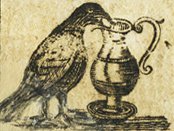 Regardless of which lesson is imparted, the story provides meaning to the interesting “Crow and
Pitcher” motif. Before reading the tale, it was difficult to see the pebble in the crow's mouth.
Afterward, it's almost impossible to miss.
Regardless of which lesson is imparted, the story provides meaning to the interesting “Crow and
Pitcher” motif. Before reading the tale, it was difficult to see the pebble in the crow's mouth.
Afterward, it's almost impossible to miss.
To read the complete fable (and more), see:
http://read.gov/aesop/012.html
THE BOOK BAZARRE
NOTGELD TALES
Alisha Ankin is a collections specialist working with the National Numismatic Collection. This week she authored a Smithsonian O Say Can You See? blog post about WWI emergency money. A couple of the pieces are especially appropriate for Halloween. See the complete article online for more. -Editor
After the end of World War I, Germany was in economic crisis and was unable to provide enough currency for its citizens. In response, cities and towns under German control created their own form of emergency currency, called notgeld, to supplement the limited national currency in circulation. The locally-issued notgeld were highly illustrated, colorful, and featured scenes of local architecture and culture.
One particularly interesting element of these notes is the frequent depiction of local legends and folklore. These scenes provide a lens into how local folklore and history might have provided messages of comfort or warning at a time of uncertainty. The following four pieces of notgeld offer a glimpse into life in Germany after the end of the First World War.
Witches
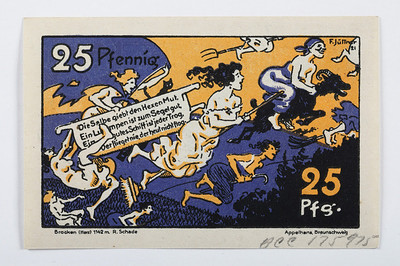
25 pfennig note, Brocken, Germany, 1921
The German Harz Mountains and the small towns settled within them have a set of legends that reflect their local geography. The foggy town of Brocken is located at the top of the range's highest peak, and the townspeople embrace the folklore with themes of witchery and devilry that helped to make the region famous. One trail is called the Witches' Path and there are local landmarks called Hexentanzplatz (Witches' Dance Floor), Teufelsmauer (Devil's Wall), Hexenaltar (Witches' Altar). This 25 pfennig note from Brocken illustrates this folklore by depicting witches flying to meet with the Devil on Walpurgis Night, the eve of May Day. On that night, townspeople in Germany light fires on hillsides or dress up as witches and demons while playing loud music and lighting fireworks as a method to drive away evil spirits and witches.
Headless Horseman
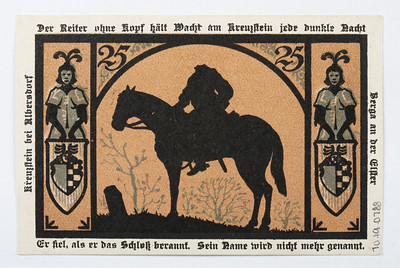
25 pfennig note, Berga, Germany, 1921
Stories from the Brothers Grimm appear on notgeld all throughout Germany, such as the headless horseman on this 25 pfennig note from Berga. Often, stories associate the headless horseman with loud or mysterious sounds or even sudden windstorms. It is believed that if a headless horseman appears to you, it is a warning to change your behavior and actions for the better or you too will suffer the same fate to wander the earth as a headless horseman.
To read the complete article, see:
The tales emergency currency can tell
(https://americanhistory.si.edu/blog/tales-emergency-currency-can-tell)
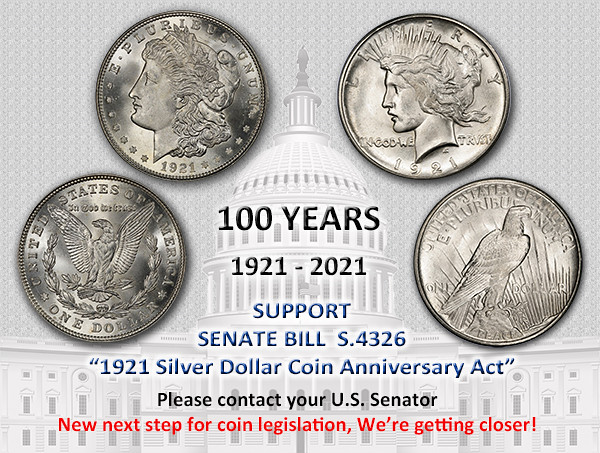
FEDERAL PRISON BANK OF ALCATRAZ OVERSTAMP
We've often discussed overstamped banknotes. An item pictured in the new book on Prison Money (described elsewhere in this issue) prompted me to reach out to co-author Bob Hewey for more information. -Editor
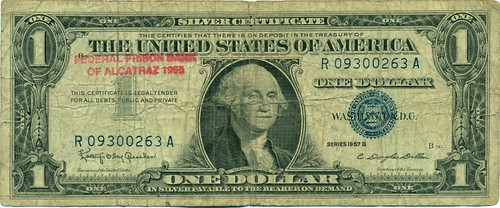
"Federal Prison Bank of Alcatraz 1955" overstamp
Bob writes:
"I bought it off of eBay in 2012 and I've seen a couple of others of the same type on eBay but never another denomination or for a different prison. I don't have any information on why or how it was used."
I'd never seen or heard of these before. Can anyone help? -Editor
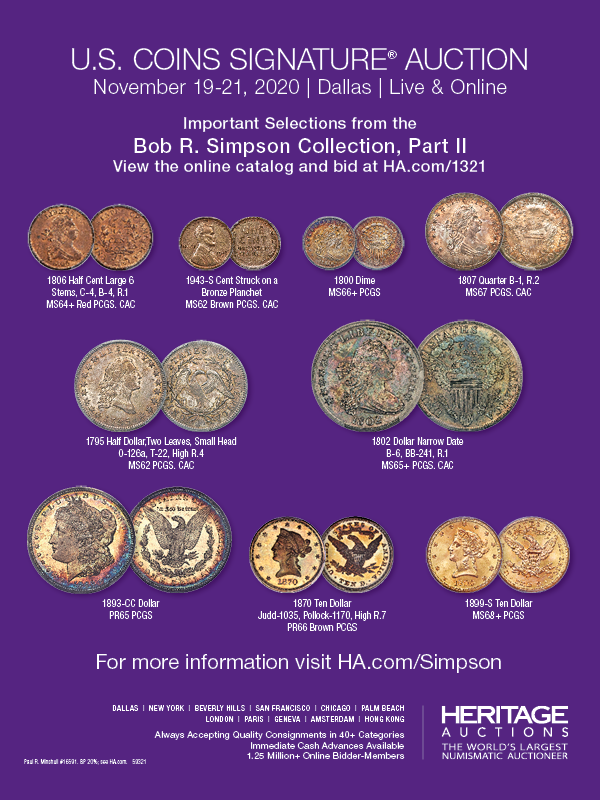
BILL FIVAZ'S WORLD'S WORST TYPE SET
Everyone wants to collect the best this or the best that. But collecting the WORST can be an affordable yet still difficult challenge. Stack's Bowers Galleries published this announcement of their upcoming sale of Bill Fivaz's "World's Worst Type Set". -Editor
In an endeavor that spanned more than 25 years, noted numismatist and researcher Bill Fivaz put considerable efforts into obtaining and downgrading coins for his self-named “World's Worst Type Set.” As those who know Bill fondly recall, he would show off these heavily worn and sometimes nearly unidentifiable coins at his local coin club and various shows. In recent years, PCGS has recognized this special area of collecting and has created “Low-Ball” Registry Sets, where the lowest grade (Poor-1) is the “best” obtainable specimen.
The true rarity of these exceedingly low-grade, yet problem-free coins is not yet fully recognized by today's collectors. However, recent landmark sales such as The D. Brent Pogue Collection Part VII, which saw prices realized into the thousands of dollars for Poor-1 certified “common” coins, have brought considerable attention to this fascinating and under-appreciated area of collecting. Bill's set comprises 99 pieces across a wide range of types and time periods, almost exclusively certified as Poor-1 or Fair-2. Stack's Bowers Galleries is honored to present this collection to lead their November Collectors Choice Online auction on November 4th, 2020.
Here are a few selections. -Editor
Lot 92001: 1837 Feuchtwanger Cent Poor-1
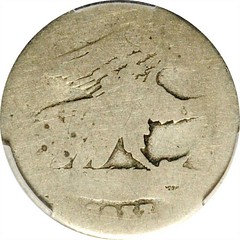
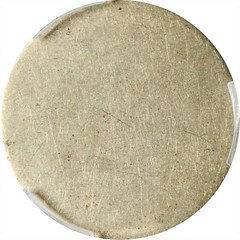
Lot 92022: 1825 Capped Bust Dime. Poor-1
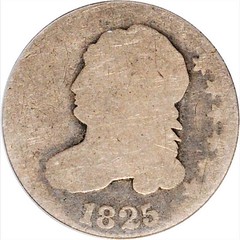

Lot 92032: 1875-S Twenty-Cent Piece. Poor-1
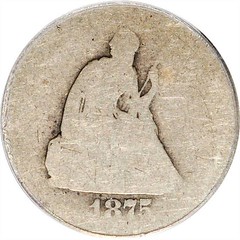
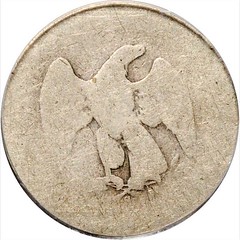
Lot 92033: 1805 Draped Bust Quarter. Fair-2
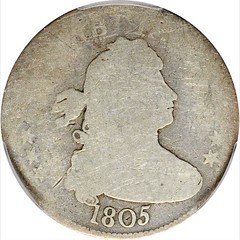
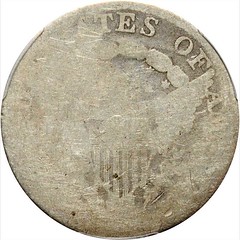
Lot 92044: 1795 Flowing Hair Half Dollar. Fair-2
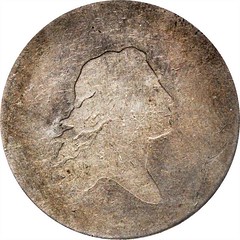
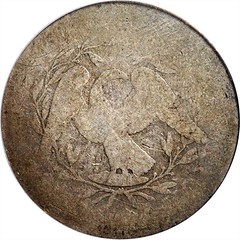
Lot 92086: 1855 Liberty Head Eagle. Fair-2
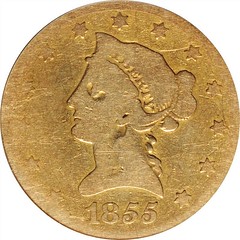
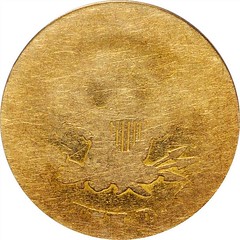
To view the lots or bid, see:
https://auctions.stacksbowers.com/auctions/3-OXEHM/the-november-2020-collectors-choice-online-auction-us-coins-featuring-bill-fivazs-worlds-worst-type-set-lots-92001-92453
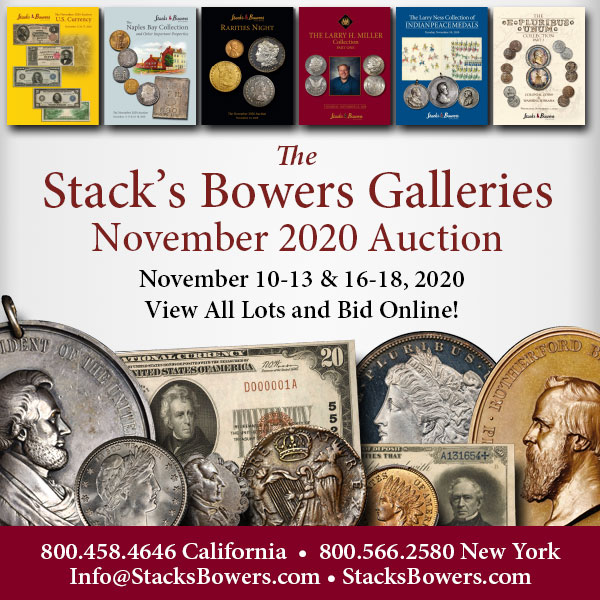
LOOSE CHANGE: NOVEMBER 1, 2020
Here are some additional items in the media this week that may be of interest. -Editor
Greek Black Sea Colonies
On CoinWeek Steve Benner published the second article in a series on the Greek colonies on the northern coast of the Black Sea. This counterstamped piece really stood out to me. -Editor
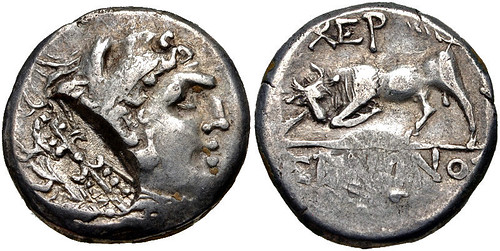
Tauric Chersonesus, Chersonesus, AR Trihemidrachm, Head of Herakles right, wearing lion skin with a thunderbolt countermark within incuse rectangle and a reverse of a bull butting left; XEP above and ?ENONOS in exergue; SNG BM Black Sea 778-82, 17.5 mm, 4.60 g, 250-230 BCE. (CNG 405, lot 155, $650, 1/26/17).
To read the complete article, see:
Tyras & Chersonesus: Ancient Greek Coins of the Black Sea's Northern Coast
(https://coinweek.com/ancient-coins/tyras-chersonesus-ancient-greek-coins-of-the-black-seas-northern-coast/)
Tulipmania: More Boring Than You Thought
Coin market bubbles have often been compared to the famous Tulipmania episode in Dutch history. Scott Miller passed along this Smithsonian article about a new book titled Tulipmania: Money, Honor, and Knowledge in the Dutch Golden Age. Thanks. See the complete article online. -Editor
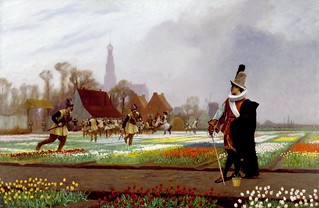 For decades, economists have pointed to 17th-century tulipmania as a warning about the perils of the free market. Writers and historians have reveled in the absurdity of the event. The incident even provides the backdrop for the film Tulip Fever, based on a novel of the same name by Deborah Moggach.
For decades, economists have pointed to 17th-century tulipmania as a warning about the perils of the free market. Writers and historians have reveled in the absurdity of the event. The incident even provides the backdrop for the film Tulip Fever, based on a novel of the same name by Deborah Moggach.
The only problem: none of these stories are true.
What really happened and how did the story of Dutch tulip speculation get so distorted? Anne Goldgar discovered the historical reality when she dug into the archives to research her book, Tulipmania: Money, Honor, and Knowledge in the Dutch Golden Age.
“I always joke that the book should be called 'Tulipmania: More Boring Than You Thought,'” says Goldgar, a professor of early modern history at King's College London. “People are so interested in this incident because they think they can draw lessons from it. I don't think that's necessarily the case.”
To read the complete article, see:
There Never Was a Real Tulip Fever
(https://getpocket.com/explore/item/there-never-was-a-real-tulip-fever)
The Coin Collection Under the Stairs
Numismatists can look forward to a coin collection theme in an upcoming movie from director Jordan Peele -Editor
Jordan Peele's next project is set to be a remake of The People Under the Stairs for Universal.
Based on Wes Craven's 1991 horror satire, Collider reports that Peele will produce the new film alongside Win Rosenfield via their Monkeypaw Productions house. It isn't anticipated that Peele will direct himself, and it's not known if he'll take part in writing the script.
The original film starred Brandon Adams, Everett McGill, Wendy Robie, A.J. Langer, and Ving Rhames, and celebrates its 29th anniversary on Nov. 1. Craven's plot told the story of a young boy and two adults who try to steal a rare coin collection from a strange couple's home. However, the trio end up becoming trapped in the house owned by the Robesons.
To read the complete article, see:
(https://www.complex.com/pop-culture/2020/10/jordan-peele-produce-remake-wes-craven-the-people-under-the-stairs)

FEATURED WEB PAGE: BEARD TAX
This week's Featured Web Page is a Wikipedia history of beard taxes and the Russian beard tokens.
In 1698, Emperor Peter I of Russia instituted a beard tax to bring Russian society in line with Western European models. To enforce the ban on beards, the tsar empowered police to forcibly and publicly shave those who refused to pay the tax. Resistance to going clean shaven was widespread with many believing that it was a religious requirement for a man to wear a beard.
The tax levied depended upon the status of the bearded man: those associated with the Imperial Court, military, or government were charged 60 rubles annually; wealthy merchants were charged 100 rubles per year while other merchants and townsfolk were charged 60 rubles per year; Muscovites were charged 30 rubles per year; and peasants were charged two half-kopeks every time they entered a city.
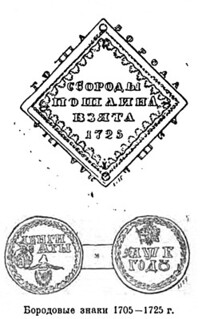
https://en.wikipedia.org/wiki/Beard_tax

